ASUSTeK Computer P525 QUAD-BAND SMART PHONE User Manual users manual 1 of 2
ASUSTeK Computer Inc QUAD-BAND SMART PHONE users manual 1 of 2
Contents
users manual 1 of 2
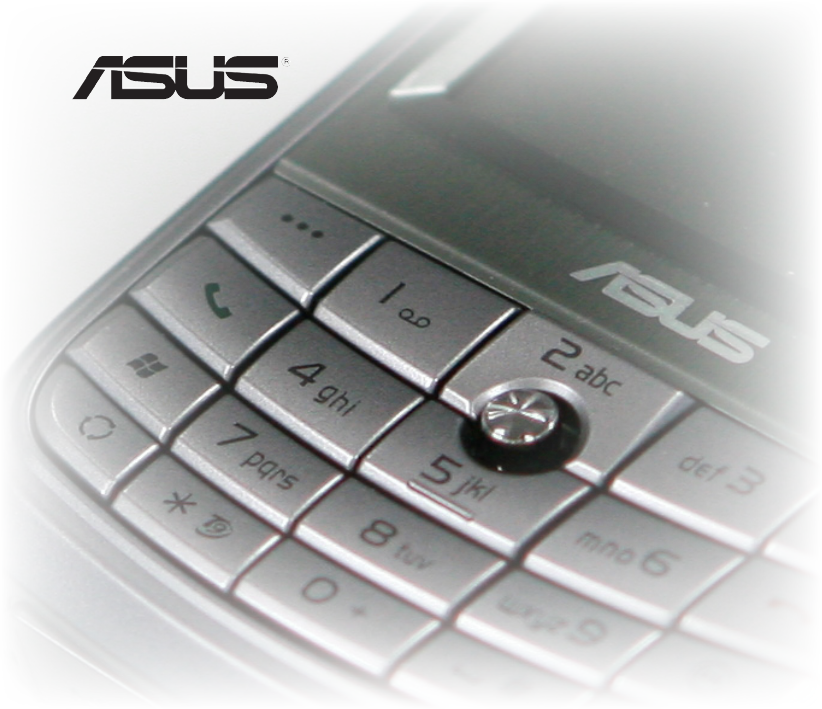
P525
User Manual

2
E2653
Revised Edition V2
June 2006
Copyright © 2006 ASUSTeK COMPUTER INC. All Rights Reserved.
No part of this manual, including the products and software described in it, may be reproduced,
transmitted, transcribed, stored in a retrieval system, or translated into any language in any form or by any
means, except documentation kept by the purchaser for backup purposes, without the express written
permission of ASUSTeK COMPUTER INC. (“ASUS”).
Product warranty or service will not be extended if: (1) the product is repaired, modied or
altered, unless such repair, modication of alteration is authorized in writing by ASUS; or (2)
the serial number of the product is defaced or missing.
ASUS PROVIDES THIS MANUAL “AS IS” WITHOUT WARRANTY OF ANY KIND, EITHER
EXPRESS OR IMPLIED, INCLUDING BUT NOT LIMITED TO THE IMPLIED WARRANTIES OR
CONDITIONS OF MERCHANTABILITY OR FITNESS FOR A PARTICULAR PURPOSE. IN NO
EVENT SHALL ASUS, ITS DIRECTORS, OFFICERS, EMPLOYEES OR AGENTS BE LIABLE
FOR ANY INDIRECT, SPECIAL, INCIDENTAL, OR CONSEQUENTIAL DAMAGES (INCLUDING
DAMAGES FOR LOSS OF PROFITS, LOSS OF BUSINESS, LOSS OF USE OR DATA,
INTERRUPTION OF BUSINESS AND THE LIKE), EVEN IF ASUS HAS BEEN ADVISED OF THE
POSSIBILITY OF SUCH DAMAGES ARISING FROM ANY DEFECT OR ERROR IN THIS MANUAL
OR PRODUCT.
SPECIFICATIONS AND INFORMATION CONTAINED IN THIS MANUAL ARE FURNISHED
FOR INFORMATIONAL USE ONLY, AND ARE SUBJECT TO CHANGE AT ANY TIME WITHOUT
NOTICE, AND SHOULD NOT BE CONSTRUED AS A COMMITMENT BY ASUS. ASUS ASSUMES
NO RESPONSIBILITY OR LIABILITY FOR ANY ERRORS OR INACCURACIES THAT MAY
APPEAR IN THIS MANUAL, INCLUDING THE PRODUCTS AND SOFTWARE DESCRIBED IN IT.
Products and corporate names appearing in this manual may or may not be registered trademarks
or copyrights of their respective companies, and are used only for identication or explanation and
to the owners’ benet, without intent to infringe.

3
Table of Contents
P525 specications ............................................................................... 8
Package contents .................................................................................. 9
Chapter 1: Getting started
Getting to know your P525 ................................................................. 12
Layout ..................................................................................................... 12
Device components description .................................................................... 14
Getting your device ready ................................................................... 16
Installing the SIM card and battery................................................................ 16
Charging the battery...................................................................................... 18
Starting up ............................................................................................ 19
Powering your device .................................................................................... 19
Using the stylus ............................................................................................. 19
Calibrating P525............................................................................................ 20
Locking the keys and buttons........................................................................ 20
The Today screen ................................................................................ 21
Status indicators............................................................................................ 22
Screen orientation ......................................................................................... 25
Start menu..................................................................................................... 26

4
Chapter 2: Entering data
Using the Input Panel .......................................................................... 28
Using the Block Recognizer .......................................................................... 28
Using the on-screen keyboard ...................................................................... 29
Using the Letter Recognizer.......................................................................... 30
Using T9 input ............................................................................................... 31
Using the Transcriber .................................................................................... 32
Writing and drawing on the screen .................................................... 33
Recording voice ................................................................................... 34
Using ActiveSync™ ............................................................................. 36
Synchronizing via USB.................................................................................. 38
Synchronizing via Bluetooth .......................................................................... 39
Synchronizing via Infrared (IR)...................................................................... 39
Synchronizing with Exchange Server ................................................ 40
Setting the synchronization schedule............................................................ 42
Searching information ......................................................................... 43
Getting Help ......................................................................................... 44
Chapter 3: Phone features
Using phone ......................................................................................... 46
Phone pad ..................................................................................................... 46
Using ight mode .......................................................................................... 46
Adjusting the device volume ......................................................................... 47
Making a call ........................................................................................ 48

5
Using the keypad .......................................................................................... 48
Using the phone pad ..................................................................................... 48
Making calls from Contacts ........................................................................... 50
Making calls from Call History ....................................................................... 50
Using the Speed Dial .................................................................................... 51
Using Voice Command.................................................................................. 52
Receiving a call .................................................................................... 53
Chapter 4: Wireless features
Using Bluetooth® ................................................................................. 56
Overview ....................................................................................................... 56
Activating Bluetooth in your device ............................................................... 56
Conguring Bluetooth ................................................................................... 57
Using WLAN (IEEE 802.11b) ............................................................... 63
Introduction ................................................................................................... 63
Activating WLAN in your device .................................................................... 63
Conguring WLAN ....................................................................................... 64
Using Infrared (IR) ............................................................................... 66
Setting a GPRS connection ................................................................ 67
Connecting GPRS ......................................................................................... 70
Disconnecting GPRS .................................................................................... 71
Using the GPRS Tool .................................................................................... 72
Chapter 5: My Secrets
Using My Secrets ................................................................................. 74

6
Enabling My Secrets ..................................................................................... 74
Unlocking My Secrets ................................................................................... 76
Locking My Secrets ....................................................................................... 77
My Secrets setting......................................................................................... 78
Disabling My Secrets .................................................................................... 81
Chapter 6: Multimedia features
Using the camera ................................................................................. 86
Launching the camera................................................................................... 86
Joystick functions in camera mode ............................................................... 87
Camera mode screen.................................................................................... 89
Taking photos ................................................................................................ 97
Video mode screen ..................................................................................... 101
Recording videos ........................................................................................ 107
Viewing pictures and video ...............................................................111
Viewing pictures and video ..........................................................................111
Chapter 7: Other features
Business Card Reader .......................................................................114
Using the Business Card Reader .................................................................114
Setting ring tone .................................................................................117
Adding ring tone to selection ........................................................................117
Setting ring tone ...........................................................................................118
Wake-up setting ..................................................................................119
Mode switcher .................................................................................... 120

7
System information ........................................................................... 121
Restoring default factory settings ................................................... 122
Chapter 8: Device components status
ASUS status icon ............................................................................... 124
CPU mode setting ....................................................................................... 125
USB setting ................................................................................................. 125
LCD Brightness ........................................................................................... 126
Battery ................................................................................................... 126
Memory ................................................................................................... 127
Storage card memory.................................................................................. 127
Programs running in memory ...................................................................... 128
Settings ................................................................................................... 128
Appendix
Notices ................................................................................................ 130
Contact information ........................................................................... 134
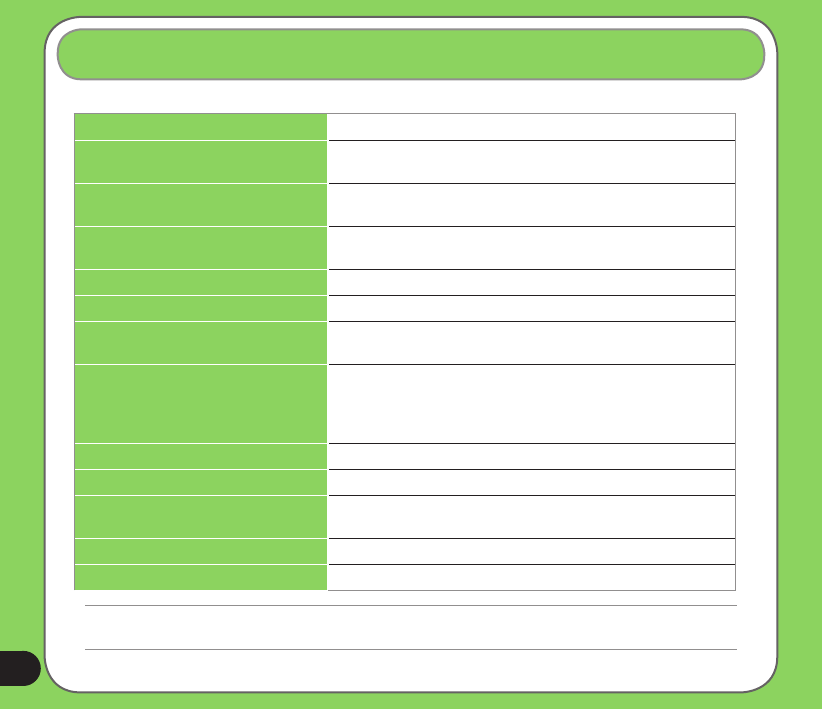
8
P525 specications
Processor Intel® XScale™ 416MHz application processor
Operating System Microsoft® Windows Mobile™ 5.0
Pocket PC Phone Edition
Memory 128 MB Flash ROM
64 MB SDRAM
Display 2.8-inch, 65, 536-color, 240 x 320-resolution, transreective
TFT touch screen LCD
Frequency band Quad-band GSM (850/900/1800/1900 MHz)
GPRS Class B, Multislot class 10
Camera 2.0 mega-pixel CMOS camera with Auto-Focus (AF) and
built-in ash
Connectivity WLAN : 802.11b
Bluetooth : V2.0
Infrared : SIR
USB : USB Client 1.1
Battery capacity 1300 mAh Lithium Ion
Expansion slots MiniSD card slot
Audio 2.5 mm audio port
Built-in microphone and speaker
Weight 160g (with battery)
Dimension 116.8 x 59 x 19 mm
NOTE:
Specications are subject to change without notice.
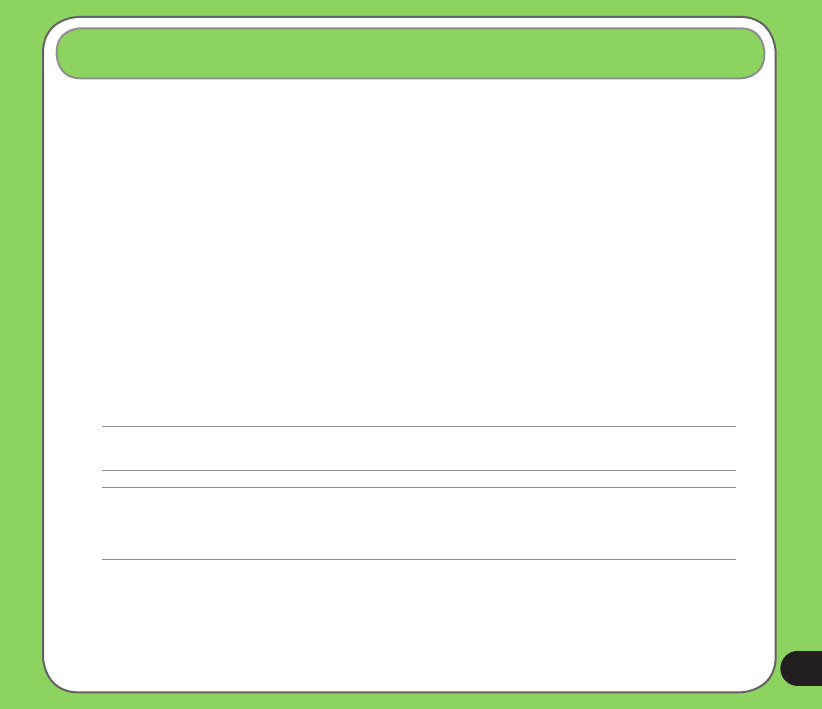
9
Check your P525 package for the following items:
• ASUS P525 device
• 1300 mAh Lithium-Ion battery
• AC Adapter
• USB Cable
• Stylus
• Protection case
• Headset
• Getting Started CD
• User Manual
• Quick Start Guide
NOTE:
If any of the above items is damaged or missing, contact your retailer.
Package contents
CAUTION:
• To reduce risk of re, use only correct battery type. Refer to “Installing the SIM card and battery” section for details.
• Do not attempt to disassemble the battery pack.
• Dispose of used batteries properly. Inquire from local authorities for proper disposal of battery.

10

11
Getting started
Chapter
• Getting to know your P525
• Getting your device ready
• Starting up
• The Today screen
1
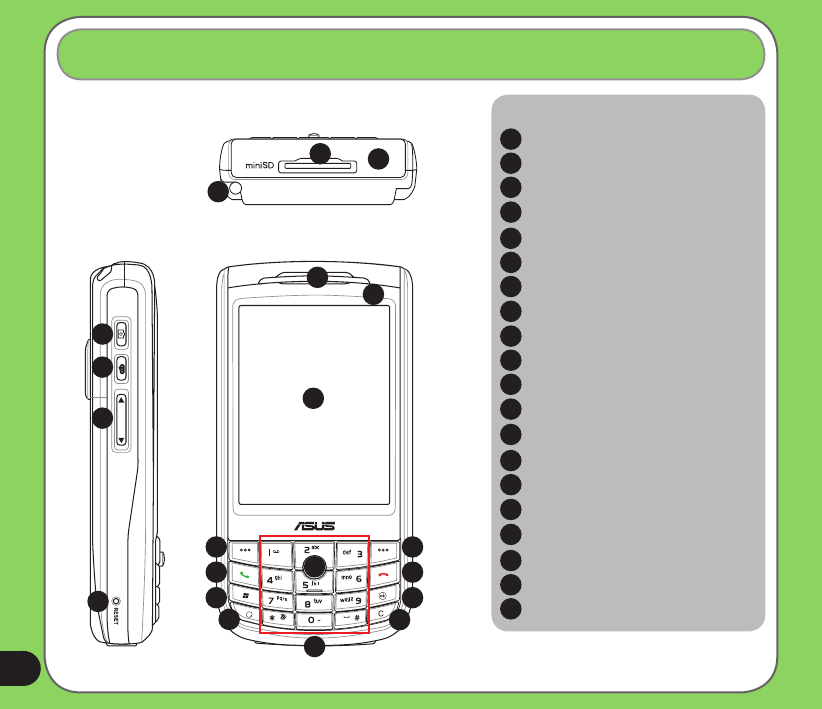
12
Getting to know your P525
Top features
Left side features Front features
1
2
4
5
6
7
9
10
11
12
13
14
17
18
19
20
15
16
Components:
Stylus
Mini-SD slot
I Infrared (IR) port
Camera button
Voice Command/Record button
Volume controller
Reset button
Earpiece receiver
Notication LED
LCD touch screen
Left Soft key
Call key
Start button
Mode/Task switcher button
5-way Joystick
Alpha-numeric keypad
Right Soft key
End key
OK or Close button
Clear button
1
2
3
4
5
6
7
8
9
10
11
12
13
14
15
16
17
18
3
8
19
20
Layout
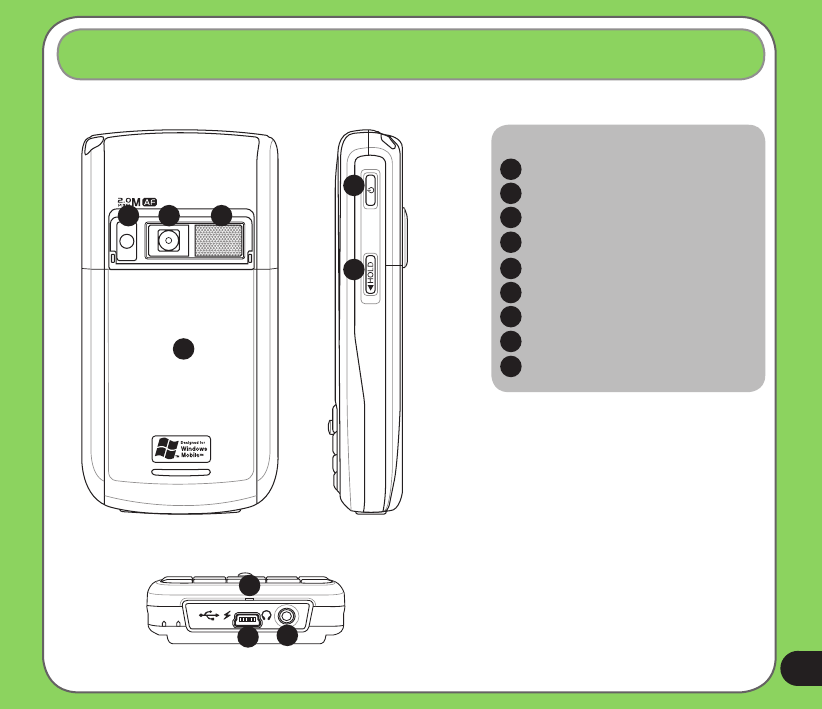
13
Getting to know your P525
Bottom features
Right side features
Rear features
29
28
25
26
24
2321 22
Components:
Camera ash light
Camera lens
Speaker
Battery compartment
Power button
Hold button
Mic
Mini-USB connector
Earphone slot
21
22
23
24
25
26
27
28
27
29
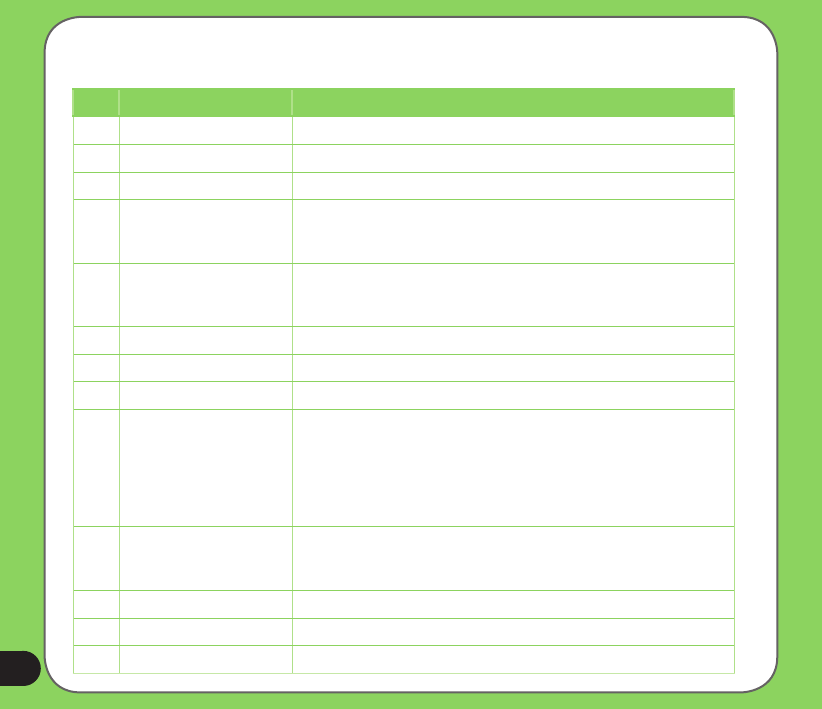
14
Device components description
No. Item Description
1Stylus Use the stylus to write, draw, or select items on the touch screen.
2Mini-SD slot Allows you to insert a Mini-SD storage card.
3Infrared (IR) port Allows you to beam data to another device that has an infrared port.
4Camera/Shutter button Press to launch the camera. In camera mode, half-press to auto-focus
then full-press to take a picture. In video mode,
full-press to start recording video and press again to stop.
5Voice Command/
Record button
Press to start voice command. Voice Command allows you to say
commands to your device. You can also press and hold this button or
tap the application record icon to record voice.
6Volume controller Press the arrow buttons to adjust the volume.
7Reset button Using the stylus, press reset button to soft-reset your device.
8Earpiece receiver Allows you to listen to incoming/outgoing calls.
9Notication LED This multi-color LED noties the following:
• Green - Phone fully charged.
• Flashing green - Network detected.
• Red - Phone is charging.
• Flashing red - Event notication.
• Flashing blue - Bluetooth
®
or WLAN(IEEE 802.11b) ON.
10 LCD touch screen This 2.8-inch, 65536-color, 240 x 320-resolution, transreective
touchscreen TFT LCD allows you to write, draw, or make selections
using the stylus.
11 Left Soft key Performs the command indicated above the button.
12 Call key Press to receive an incoming call or make a call.
13 Start button Launches the Windows Mobile
®
start menu.
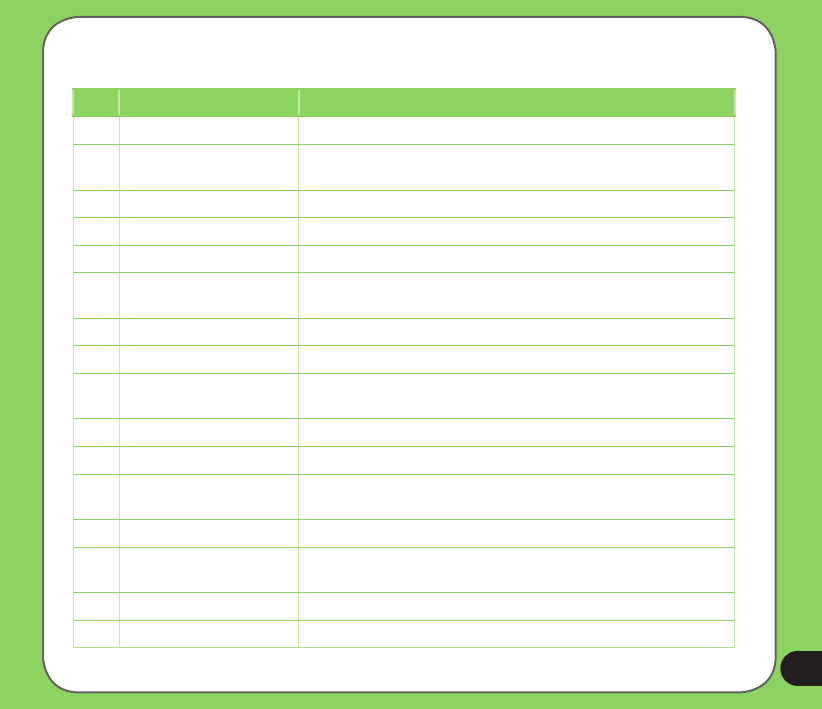
15
Device components description
No. Item Description
14 Mode/Task switcher button Allows you to switch applications and tasks.
15 5-way Joystick This 5-way joystick is used to move through menus. Press the center
to run an application or in camera mode, press to take a picture.
16 Numeric keypad Allows easy dialing when making a phone call.
17 Right Soft key Performs the task indicated above the button.
18 End button Press to end a call.
19 Ok or Close button Press to conrm a command or press to close/exit an open
application.
20 Clear button Press to delete a character or number to left.
21 Camera ash light Allows you to capture images in a dim environment.
22 Camera lens This 2-megapixel camera comes with Auto-Focus (AF) lens and ash
light features.
23 Speaker Allows you to listen audio media and incoming phone calls.
24 Battery compartment Contains the battery that supplies power to the device.
25 Power button Press once to set suspend mode or to wake device from sleep mode.
Press and hold to turn the power ON or OFF.
26 Hold button Press to disable all keys including the LCD touch screen.
27 Mic Used to answer phone calls, say voice commands, and record sounds
or voice.
28 Mini-USB connector Use this connector to synchronize your data or to charge the battery.
29 Earphone port Plug headset accessory to this port.
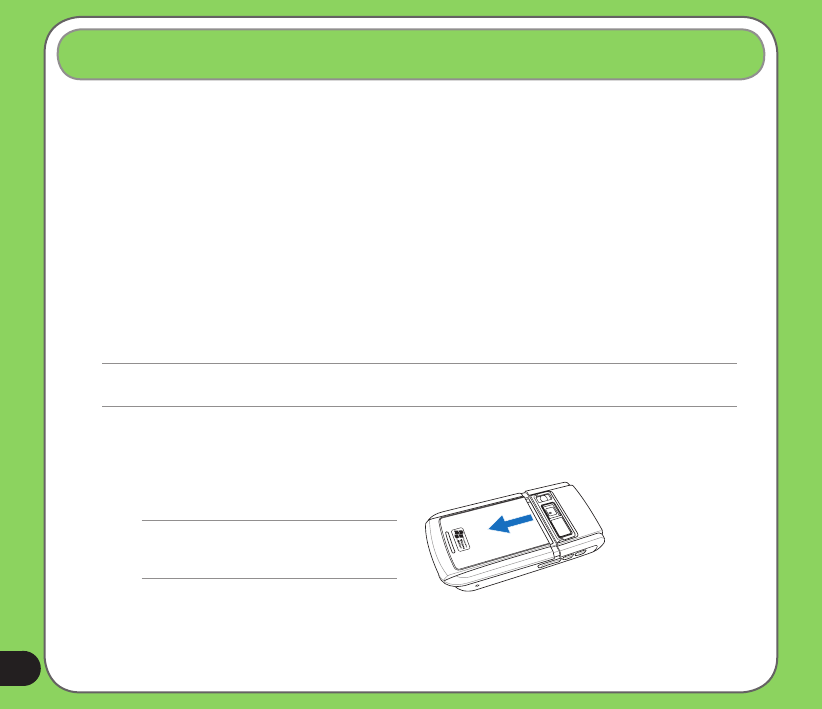
16
Installing the SIM card and battery
Before you can make a phone call using your P525, you need to install a Subscriber Identity
Module (SIM) card. A SIM card contains your phone number, subscriber details, phonebook,
and additional phone memory.
Your P525 comes with a rechargeable Lithium-Ion battery.
New batteries come partially discharged and should be fully charged before using them. They
generally do not reach their rated capacity until they have been charged and discharged at
least four (4) times. We recommended that new batteries be charged overnight even though
they may indicate that the charge is complete after a few hours. Sometimes charging may
stop during the initial charge and it is necessary to remove the battery for approximately
fteen (15) minutes and then put it back on charge.
Getting your device ready
1. Remove the battery compartment over.
NOTE:
If the device is on, it automatically turns off
after you open the battery compartment.
CAUTION:
Use only an ASUS qualied battery.
To install a SIM card and battery:
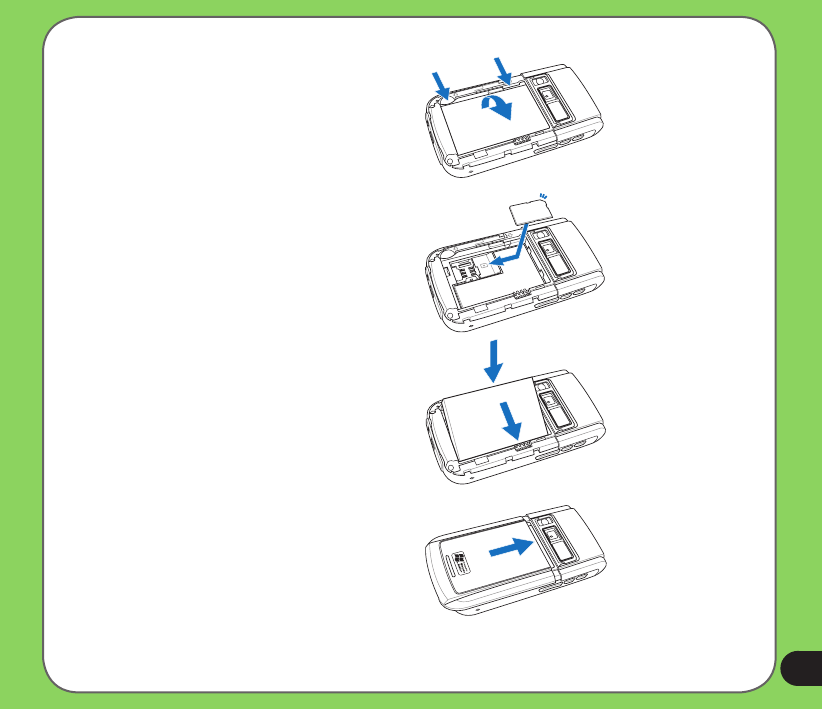
17
2. Remove the battery.
3. Insert the SIM card with its gold
contacts facing down and the notched
corner oriented to the upper left corner
of the slot as shown.
4. Replace the battery into the
compartment with its copper contacts
aligned to the copper conductor on the
device.
5. Replace battery compartment cover.
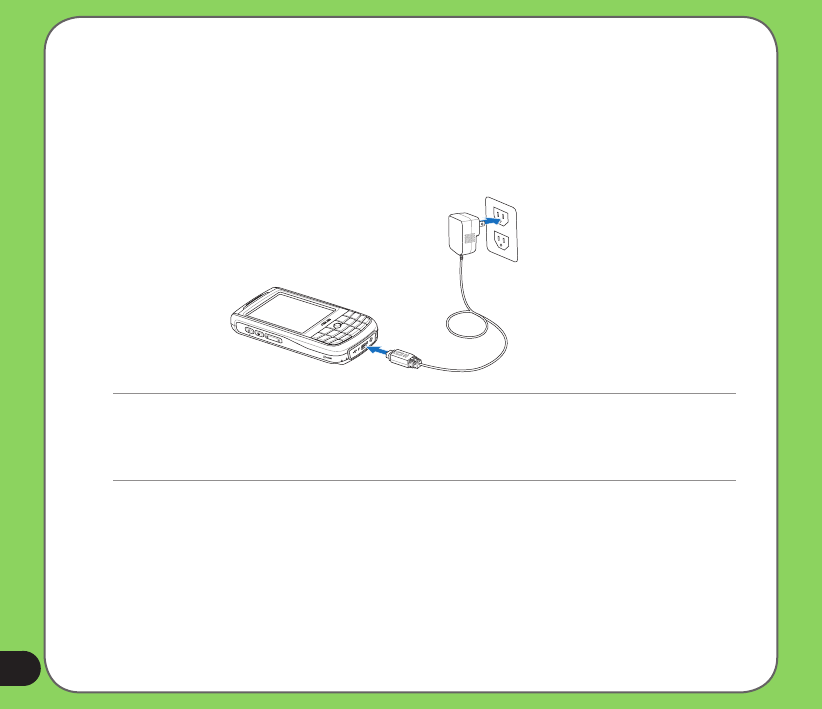
18
Charging the battery
The bundled battery pack is shipped partially charged. Charge the battery up to four (4) hours
before using for the rst time.
To charge battery:
1. Connect the AC adapter plug to the system connector at the bottom of the device.
2. Connect the AC power plug to a grounded wall socket or power strip.
NOTE:
• The notication LED turns red and charging battery icon appears on the status bar indicating that the battery is
charging.
• If your battery gets totally discharged, you need to recharge it for at least twenty minutes before you can turn it
back on.
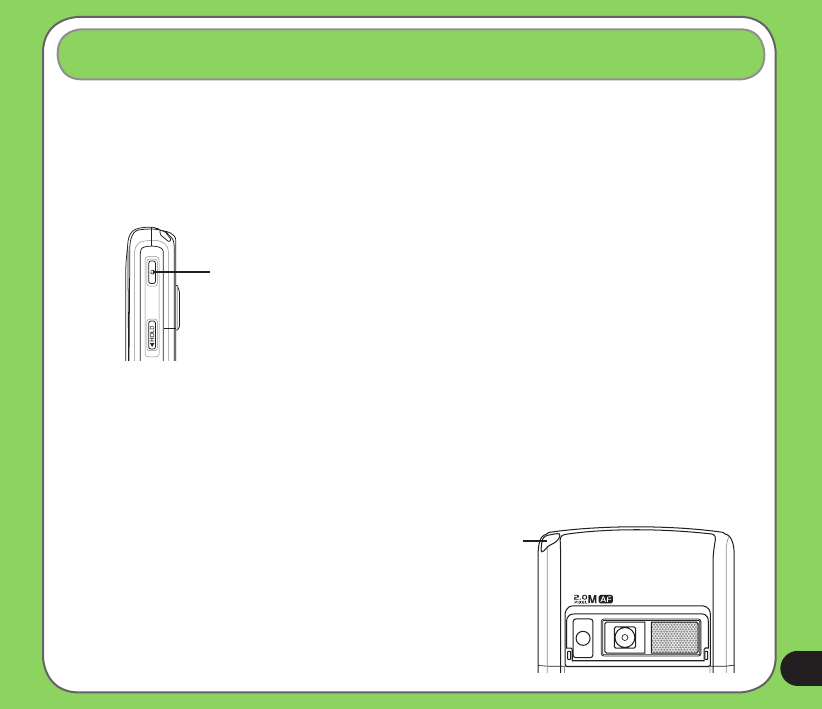
19
Powering your device
Make sure that your P525 is fully-charged before starting the device for the rst time.
To turn on power:
1. Press and hold the power button.
Power button
Starting up
2. Follow onscreen instructions to align screen and set the local time zone.
Using the stylus
The stylus is a pen-like device found behind the upper right corner of your P525.
• Use the stylus to write, draw, select, or drag an item on the screen.
• Single-tap an item to select it.
• Tap and hold an item to see a menu.
Stylus
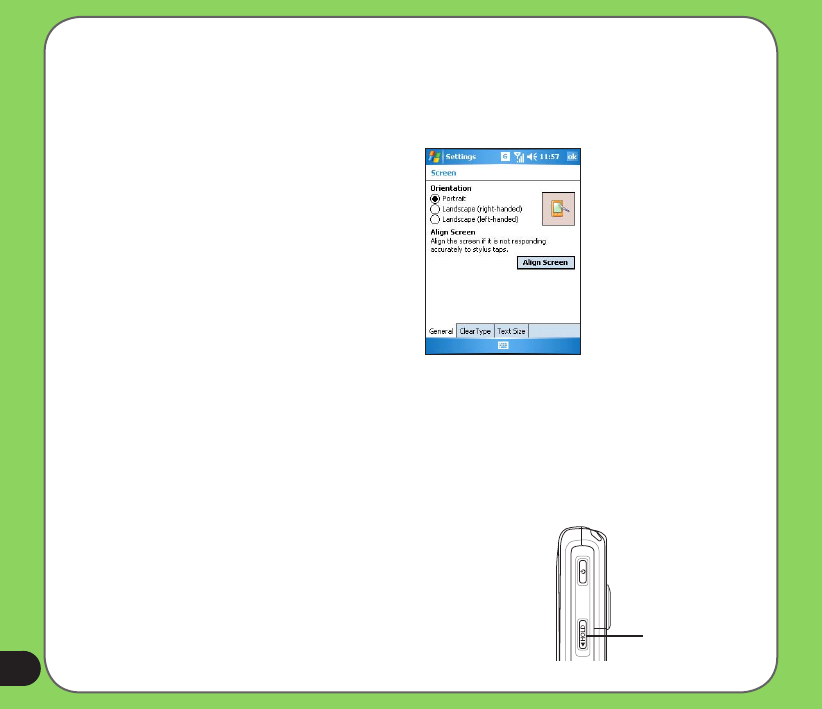
20
Calibrating P525
Calibrating your device ensures that the item you tap on the screen is activated. This involves
tapping in the center of targets that appear in various coordinates on the screen.
To calibrate your screen:
Locking the keys and buttons
You can lock the keys and buttons of your device to avoid inadvertently dialing numbers or
launching any application. To lock the keys and buttons:
1. Locate the Hold button on the right side of your device.
2. Slide the hold button downward to lock.
3. To unlock, slide the hold button upward.
Hold button
1. Tap Start > Settings > System tab
then tap Screen icon.
2. On the General tab tap Align Screen
and follow succeeding calibration
screen instructions.
You can also invoke the calibration screen by
simultaneously pressing the Mode and Clear
buttons.
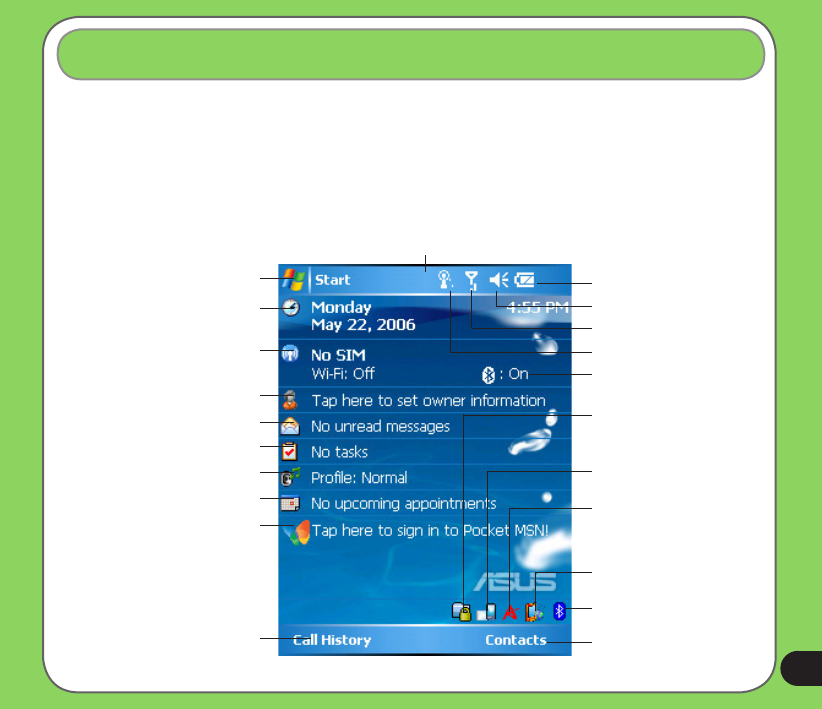
21
Tap to open the Start menu
Tap to setup date, time, and alarm.
Displays the current network
provider and connection status
Tap to set user information
Tap to open messages
Tap to setup tasks
Tap to setup prole
Tap to read or make appointments
Tap to sign in Pocket MSN
Tap to display call history
Indicates the battery status
Tap to adjust volume
Displays the signal status
Tap to view connectivity status
Tap to change WLAN
(IEEE 802.11b) settings
Tap to display system CPU,
USB setting, LCD brightness,
battery, memory, and MiniSD
status
Tap to launch Contacts list
Tap to change Bluetooth
settings
Tap to lock, unlock, or change
My Secrets settings
(Appears only when My Secrets is enabled.)
Tap to change screen
orientation
Displays the Bluetooth®
connection status
The Today screen
The Today screen displays information useful to you. You can congure the Today screen to
have all the important information you need.
• To access the Today screen, tap Start > Today.
• To personalize the Today screen, tap Start > Settings > Personal tab > Today.
The following describes the common information found on the today screen:
Status bar
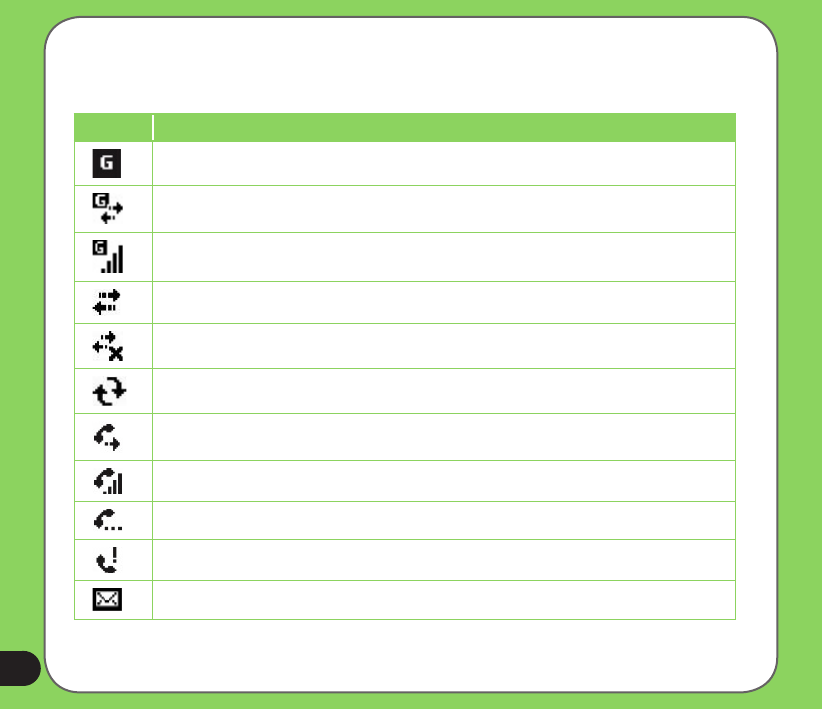
22
Status indicators
Refer to the table below for the Today screen icon status indicators.
Icon Description
General Packet Radio Services (GPRS) available.
Connecting via GPRS.
Connected via GPRS.
Connecting with ActiveSync
ActiveSync connection not active.
ActiveSync synchronization in progress.
Call forwarded.
Call in progress.
Call on hold.
Missed call.
New message.
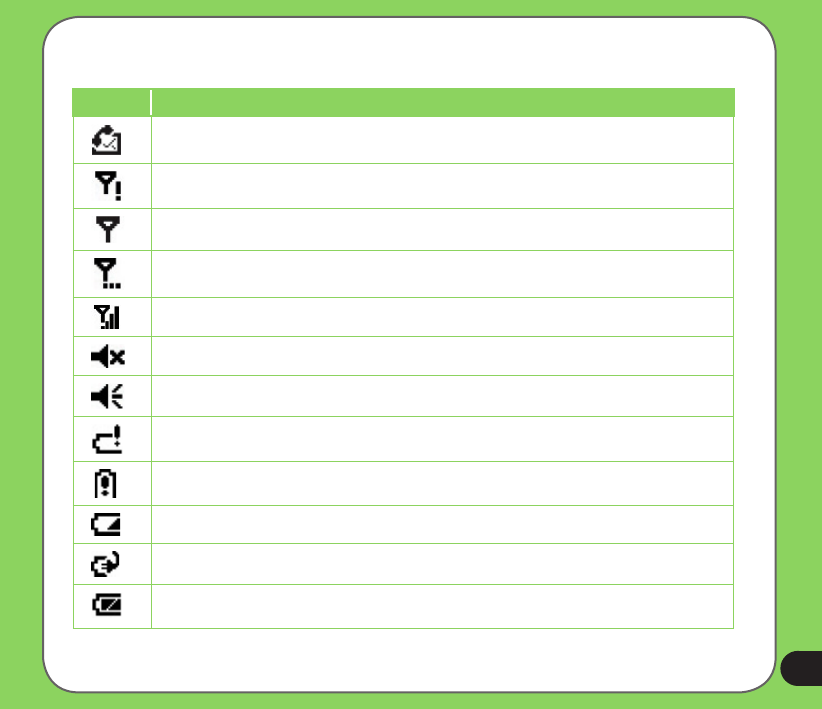
23
Status indicators
Icon Description
New voice mail.
No cellular phone service.
No signal.
Searching for cellular phone service.
Indicates signal strength.
Sound OFF.
Sound ON.
Battery low.
Battery extremely low.
Battery partially charged.
Battery charging.
Battery fully charged.
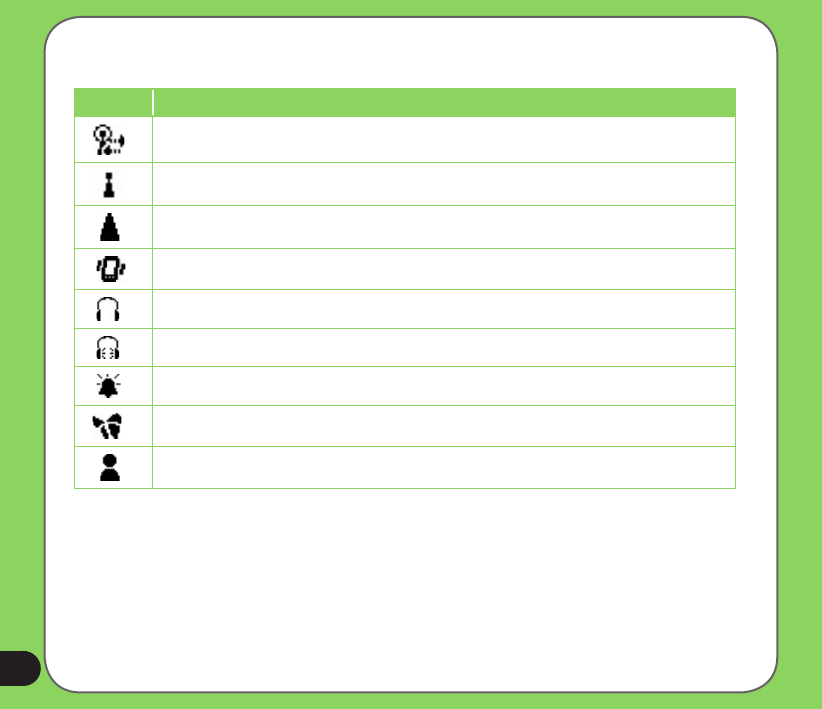
24
Status indicators
Icon Description
Searching Wi-Fi connection.
Wi-Fi active.
Roaming service. This icon appears only if you have international roaming feature.
Vibrate or silent mode on.
Bluetooth headset connected.
Bluetooth head connected with sound.
Appears when you set alarm
Pocket MSN service notication.
Pocket MSN chat is online.
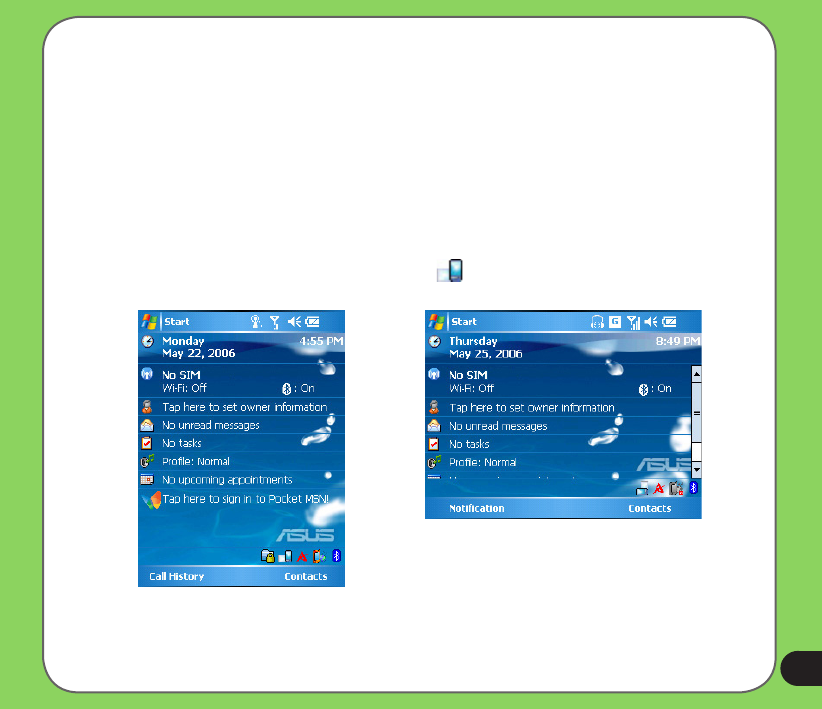
25
Screen orientation
You can set the screen to three different orientations:
1. Portrait
2. Landscape (right-handed)
3. Landscape (left-handed)
Set to Portrait mode to get a better view or better operation of certain applications on your
device. Set to Landscape when viewing pictures, video or viewing longer text les.
To change the screen orientation, tap Start > Setting > System tab > Screen then select the
orientation you want.
You can also change the orientation by tapping the icon.
Portrait mode
Landscape mode
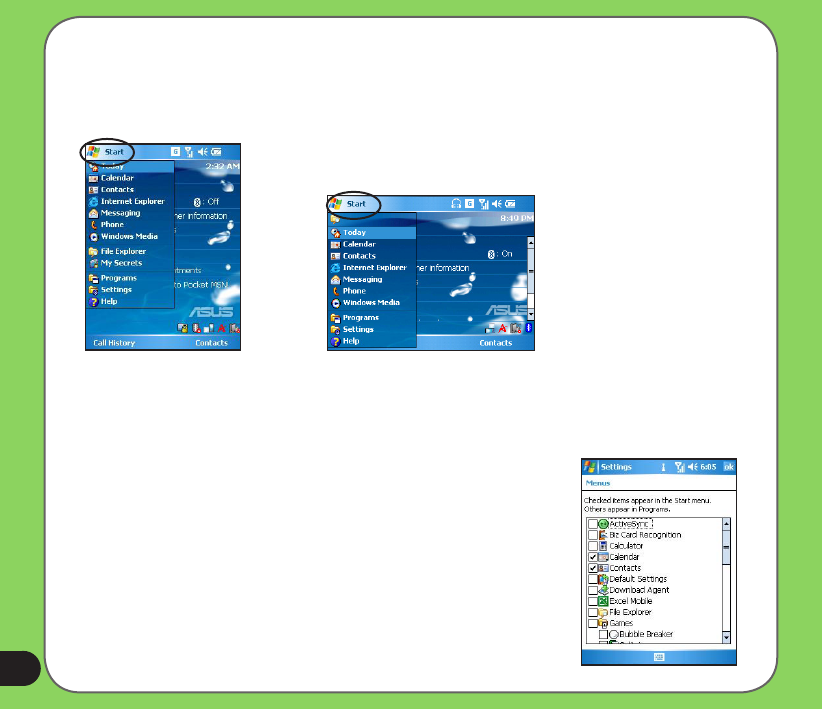
26
Start menu
The Start menu contains various programs and applications that you commonly use.
Tap Start to display the start menu items:
You can also customize the items that appear in the Start menu.
To do this:
1. Tap Start > Settings > Personal tab > Menus.
2. Select the check boxes of the items you want to appear in the
Start menu. You can select up to seven (7) items.
Portrait mode Landscape mode

27
Entering data
Chapter
• Using the Input Panel
• Writing and drawing on the screen
• Recording voice
• Using ActiveSync™
• Synchronizing with Exchange Server
• Searching information
• Getting Help
2
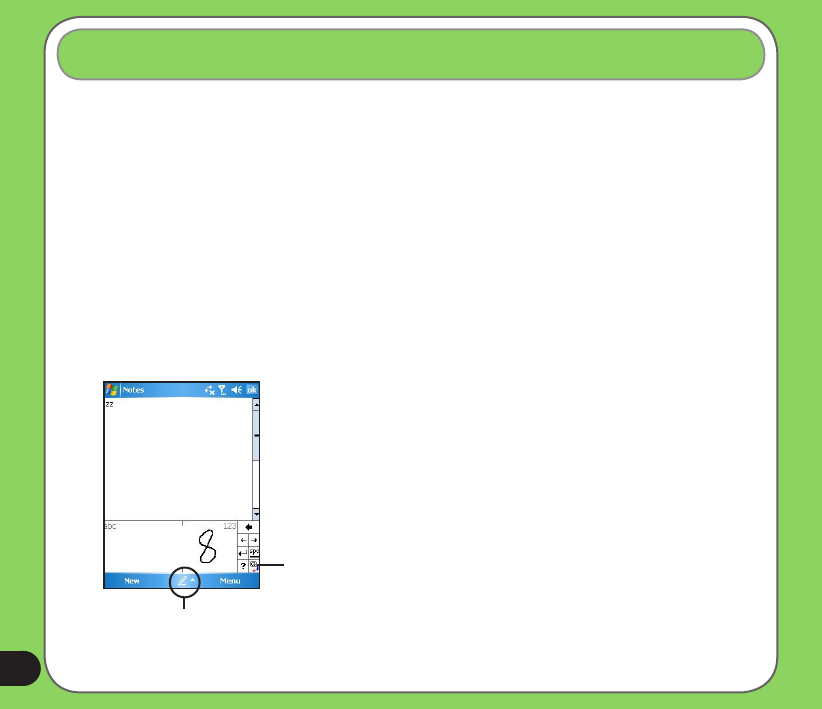
28
Using the Input Panel
When you start an application or select a eld that requires text, symbols, or numbers, the
Input Panel icon appears on the menu bar. The Input Panel allows you to select various input
methods available on your device including: Block Recognizer, Keyboard, Letter Recognizer,
T9, and Transcriber.
Using the Block Recognizer
The Block Recognizer allows you to use a single stroke to write letters, numbers, symbols, or
punctuations, which are converted into typed text.
To use the Block Recognizer:
1. In an application, tap the Input Panel arrow, then tap Block Recognizer.
2. Write letters, numbers, symbols, or punctuations in the designated writing area.
Input panel
• Write letters on the abc (left) area of the box.
• Write numbers on the 123 (right) area of the box.
• Tap the special symbols button to key in symbols, punctuations
and other special characters.
• Tap Help “?” button for help on how to write characters.
Tap for special
characters
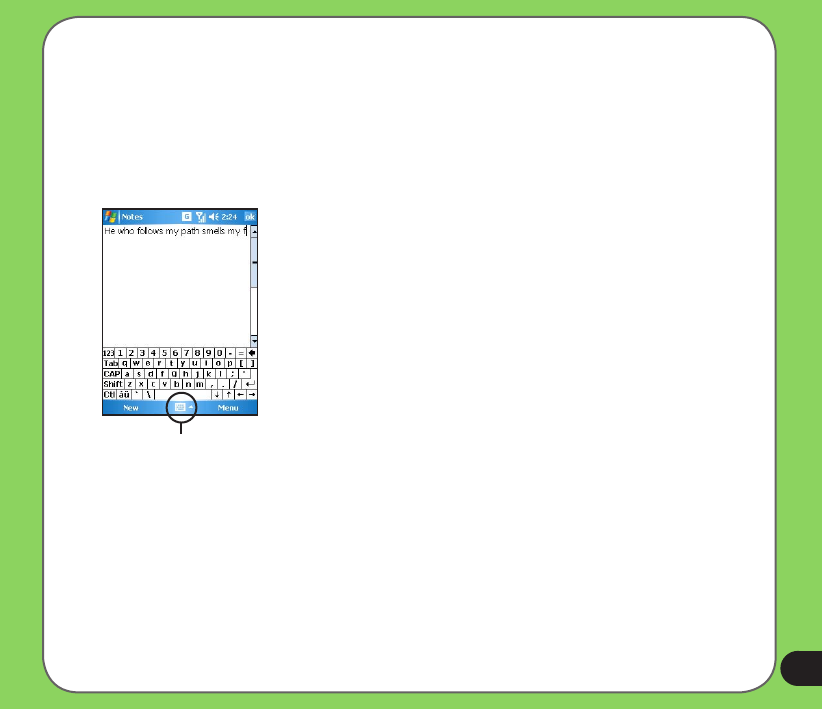
29
Using the on-screen keyboard
With the on-screen keyboard, you can key in text, symbols, numbers, or other special
characters when input is possible.
To input text using the on-screen keyboard:
1. In an application, tap the Input Panel arrow, then tap Keyboard.
2. Key in text by tapping keys on the on-screen keyboard.
Input panel
To enlarge the on-screen keyboard:
1. Tap the Input Panel arrow, then tap Option.
2. Select Keyboard from the Input Method list.
3. Tap Large Keys.
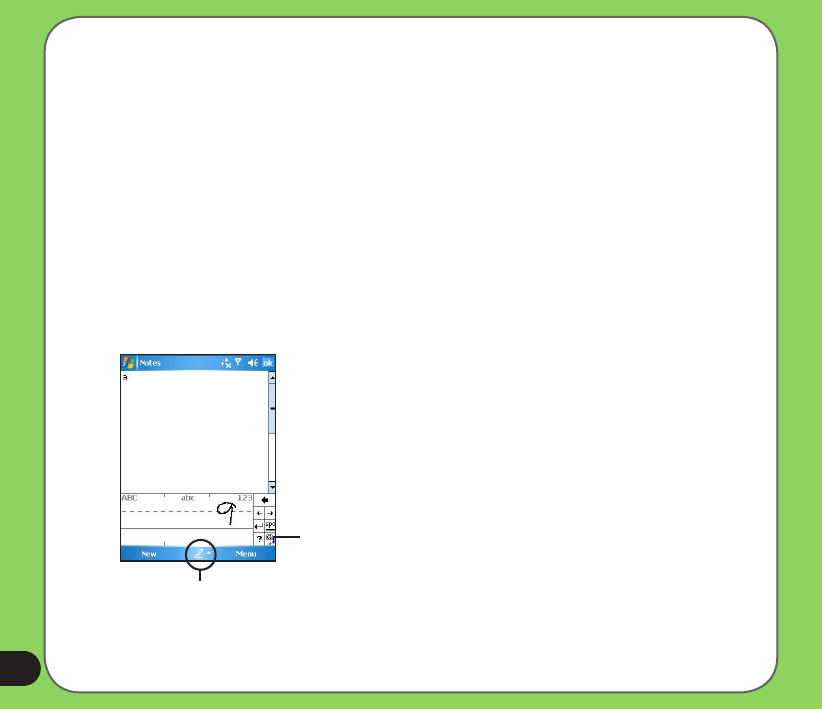
30
Using the Letter Recognizer
With the Letter Recognizer you can write individual letters, numbers, or special characters,
which are converted into typed text.
To use the Letter Recognizer:
1. In an application, tap the Input Panel arrow, then tap Letter Recognizer.
2. Write letters, numbers, symbols, or punctuations in the designated writing area.
• Write capital letters on the ABC (left) area of the box.
• Write lower case letters on the abc (middle) area of the box.
• Write numbers on the 123 (right) area of the box.
• Tap the special symbols button to key in symbols, punctuations and other special
characters.
• Tap Help “?” button for help on how to write characters.
Input panel
Tap for special
characters
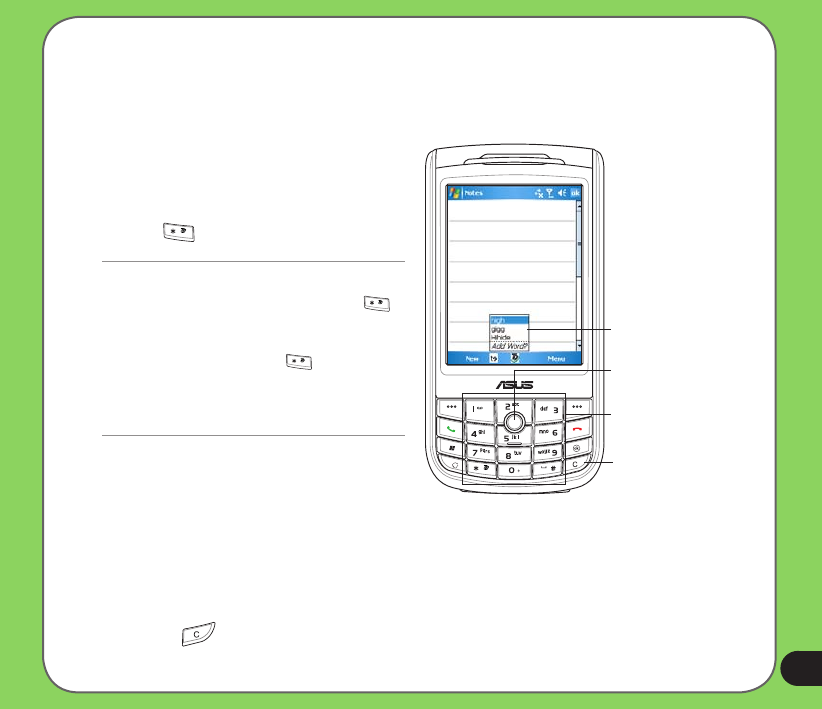
31
Using T9 input
T9 allows you to enter text in alpha-numeric format. As you key in alpha-numeric texts on the
keypad, T9 automatically matches your input with most likely the completed word.
To switch to T9 input:
Use joystick to select word
Press to delete character or
selected text to the left
Alpha-numeric keypad
Word list
• In an application, tap the Input Panel
arrow, then tap T9 or
• While you are editing a document and
T9 is not your input method, long
press key to switch to ASUS T9.
T9 input shortcuts
• To key in a word or number, tap the keys on the keypad.
• To insert a word or number from the word list:
a. Use joystick to move highlighted bar on word list.
b. Press joystick to add selected word or number.
c. Press to delete previous character or highlighted text.
TIP:
• To switch between “Symbols”, “123”, Abc”, and
“T9 English” while using T9 input, long press
key to display shortcut menu then use joystick to
select your choice.
• While you are editing a document and T9 is not
your input method, long press key to switch to
ASUS T9.
• After using T9 as input method, tap the Input icon to
minimize the keypad or long press “*” key to switch
to other input methods.
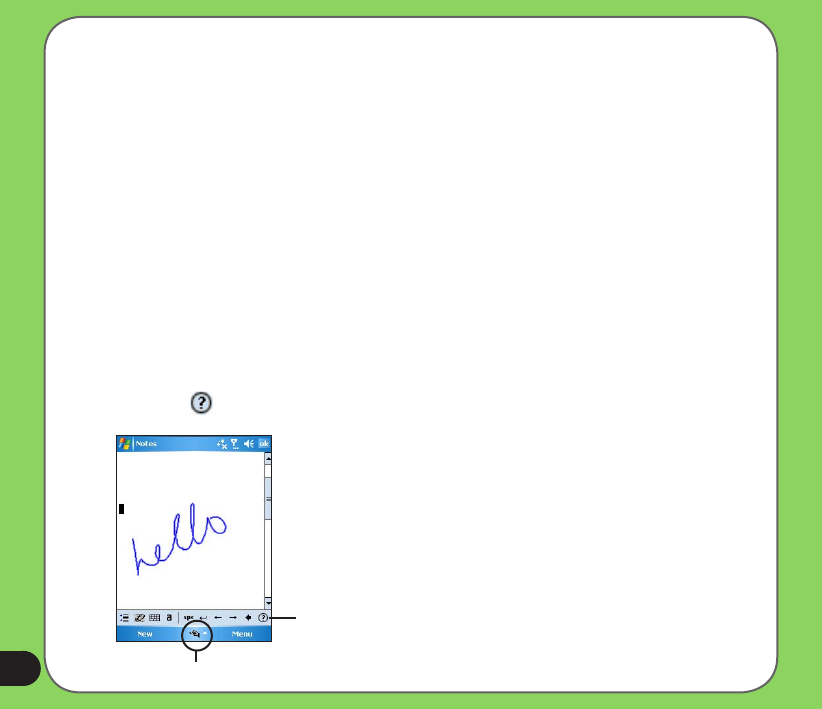
32
Using the Transcriber
Transcriber is a handwriting recognition program that allows you to write in cursive, print, or
mixed styles. It reliably recognizes not only written text but also numbers and symbols. Make
sure to write legibly. See Help for more information on the Transcriber.
To use the Transcriber:
1. Start an application that accepts user input, such as Notes or Word Mobile.
2. Tap the Input Panel arrow, then tap Transcriber.
To write using Transcriber (using Notes):
1. Tap screen to position the cursor where you want the text to appear.
2. Use the stylus to write on the screen. The handwriting will be converted to text after you
lift the stylus from the screen.
To edit text:
1. Draw a line across the text you want to edit. After you lift the stylus from the screen, the
line will disappear and the selected text will be highlighted.
2. You can now rewrite the text or use the Transcriber gestures to edit your selected text.
See Help for the Transcriber gestures.
Input panel
Tap for Help
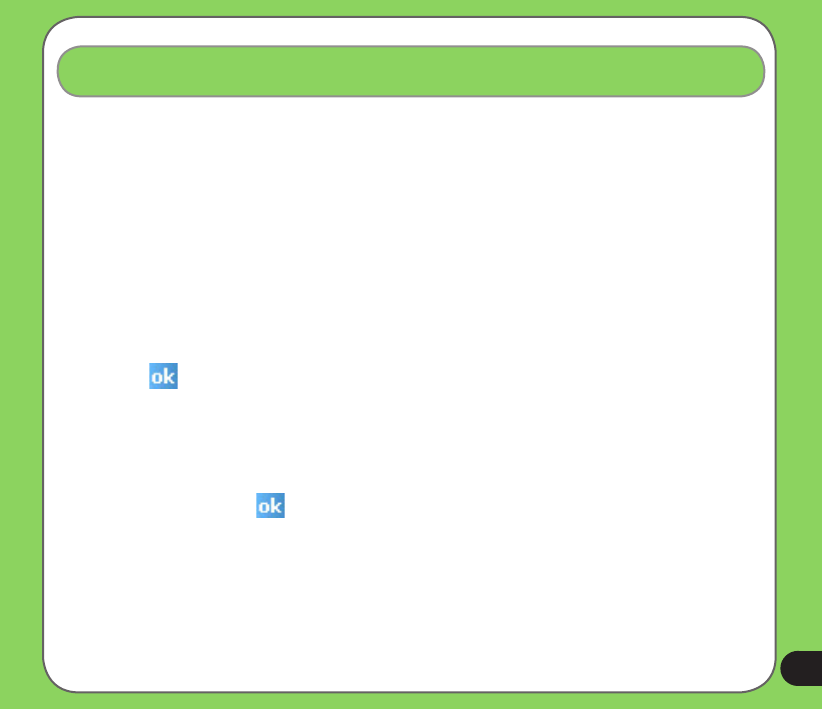
33
Writing and drawing on the screen
You can write or draw directly on the screen and save notes in your own handwriting. If you
prefer to use your own handwriting or use drawings in your notes, set the default input mode to
Writing. If you prefer text, set the default mode to Typing.
To set the default input mode for Notes:
1. Tap Start > Programs > Notes.
2. From the Notes list, tap Menu > Options.
3. In the Default mode: box, tap the down arrow and select any of the following:
• Writing - if you want to draw or enter handwritten text in a note.
• Typing - if you want to create a typed note.
4. Set the other options according to your preference.
5. Tap when nished.
To write a note:
1. Tap Start > Programs > Notes.
2. From the Notes list, tap New.
3. Write your text on the screen.
4. When nished, tap to return to the Notes list.
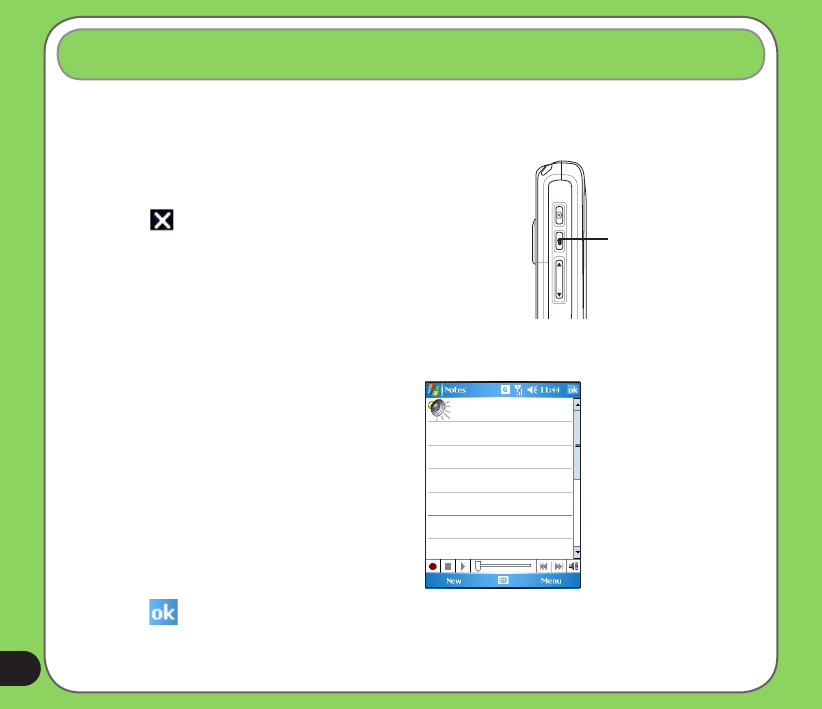
34
Recording voice
You can record sound, voice, or add a recording to a note using your device.
To start a voice recording:
1. Press and hold the Record button while recording.
2. Release to stop recording.
3. Tap to close and exit.
To create a voice recording using Notes:
1. Tap Start > Programs > Notes.
2. From the Notes list, tap New.
3. If you do not see the recording toolbar,
tap Menu > View Recording Toolbar.
4. Tap the record icon to begin recording.
5. Place the receiver near your mouth or
source of sound.
6. Tap the stop icon when nished
recording. A recording icon appears on
the note.
7. Tap .
Press and hold to record

35
To add a recording to a saved note:
1. Tap Start > Programs > Notes.
2. From the Notes list, tap to open a saved note.
3. If you do not see the recording toolbar, tap Menu > View Recording Toolbar.
4. Tap the record icon to begin recording.
5. Place the receiver near your mouth or source of sound.
6. Tap the stop icon when nished recording. A recording icon appears on the note.
7. Tap .

36
Using ActiveSync™
ActiveSync™ allows you to synchronize data in your device with data in your computer.
ActiveSync can also synchronize over a wireless or cellular network with Microsoft Exchange
Server, provided that your cellular phone service or company is running Microsoft Exchange
Server with Exchange ActiveSync. When synchronized directly with Exchange Server, you can
stay up to date even when your PC is turned off.
During synchronization, ActiveSync compares the data in your device with the data in your
computer or Exchange Server, and updates all data with recent changes.
You can select and synchronize data in the following locations using ActiveSync:
• Contacts
• Calendar
• Email
• Tasks
• Notes
• Favorites
• Files
• Media
You can also exchange data between your computer and device without synchronizing.
ActiveSync is already installed in your device, but before you can synchronize data with
your computer, you must rst install ActiveSync in your computer. Install ActiveSync from the
Microsoft companion CD that came with your device package.
After you have installed ActiveSync, set up a sync relationship between your device and your
computer. ActiveSync recognizes your device and automatically transfers the synchronization
settings you have in your device.

37
If you wish to synchronize your device with Exchange Server through your company or service
provider, obtain the name of the Exchange Server, user name, password, and domain name
from your network administrator before starting the Sync Setup Wizard.
To install and congure ActiveSync in your computer:
1. Insert the Microsoft companion CD that came with your device package.
2. Follow succeeding screen instructions.
3. After the setup is complete, the Sync Setup Wizard automatically starts when you
connect your device to your computer. Follow screen instructions to complete the wizard.
4. From the Sync Setup Wizard, you can:
• Congure an Exchange Server connection to synchronize directly with an Exchange
Server. Acquire from your network administrator the required parameters for input.
• Create a synchronization relationship between your computer and your device.
5. Select the information type that you want to synchronize.
6. After you nish the wizard, ActiveSync automatically synchronizes your device. You can
disconnect the device after the synchronization is complete.
NOTE:
• When connected, your device is automatically synchronized with your computer. ActiveSync synchronizes everytime
you make a change on either the device or computer.
• You cannot use WLAN to synchronize database.
• Refer to your Windows® Mobile Help, for more information about ActiveSync synchronization.
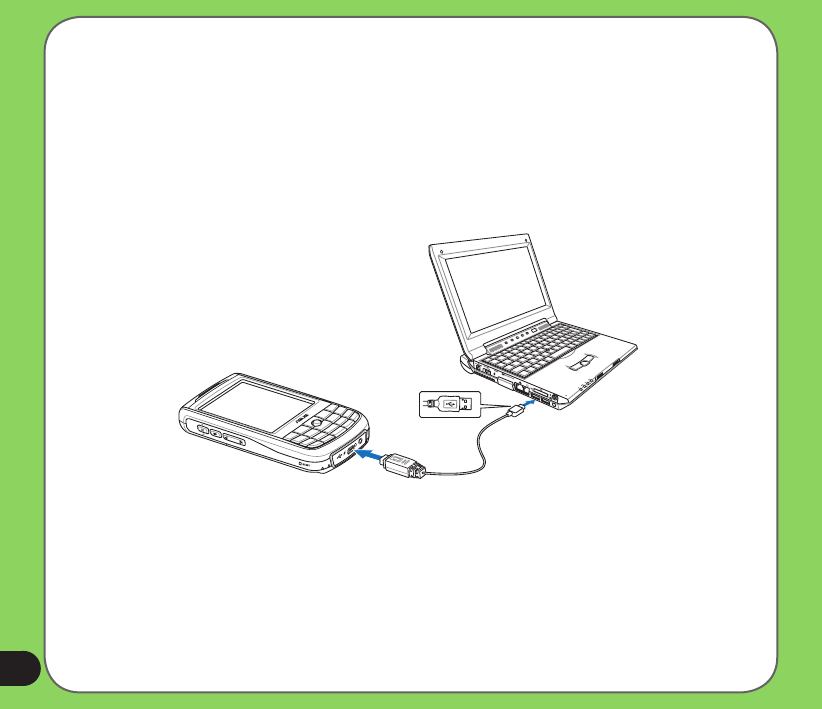
38
Synchronizing via USB
You can connect to your device using the bundled USB cable to synchronize to your computer.
To synchronize your device via USB:
1. After installing ActiveSync to your computer, connect the USB plug to the mini-USB
connector at the bottom of the device.
2. Connect the other end of the USB cable to your computer. Upon connection, ActiveSync
automatically synchronizes your device.

39
Synchronizing via Bluetooth
You can connect your device to your computer using the Bluetooth wireless technology.
To synchronize your device via Bluetooth:
1. Congure Bluetooth in your computer to support ActiveSync. Refer to the ActiveSync
Help in your computer for instructions.
2. Turn on Bluetooth in your device. See “Using Bluetooth” section in Chapter 4 for details.
3. On your device, tap Start > Programs > ActiveSync.
4. From the ActiveSync screen, tap Menu > Connect via Bluetooth. Make sure your
device is within Bluetooth range with your computer.
If this is the rst time you connect to this computer via Bluetooth, perform the Bluetooth
wizard in your device and setup a Bluetooth partnership between your device and
computer. Refer to Chapter 4 for Bluetooth wireless connection settings.
Synchronizing via Infrared (IR)
You can connect your device to your computer using the built-in Infrared port.
To synchronize your device via Infrared (IR):
1. Congure ActiveSync in your computer to receive infrared beams. Refer to the
ActiveSync Help in your computer for instructions.
2. On your device, tap Start > Programs > ActiveSync.
3. From the ActiveSync, tap Menu > Connect via IR. Make sure that the IR port in your
device is lined-up and in close range with the IR port of the computer.
4. Tap Sync.
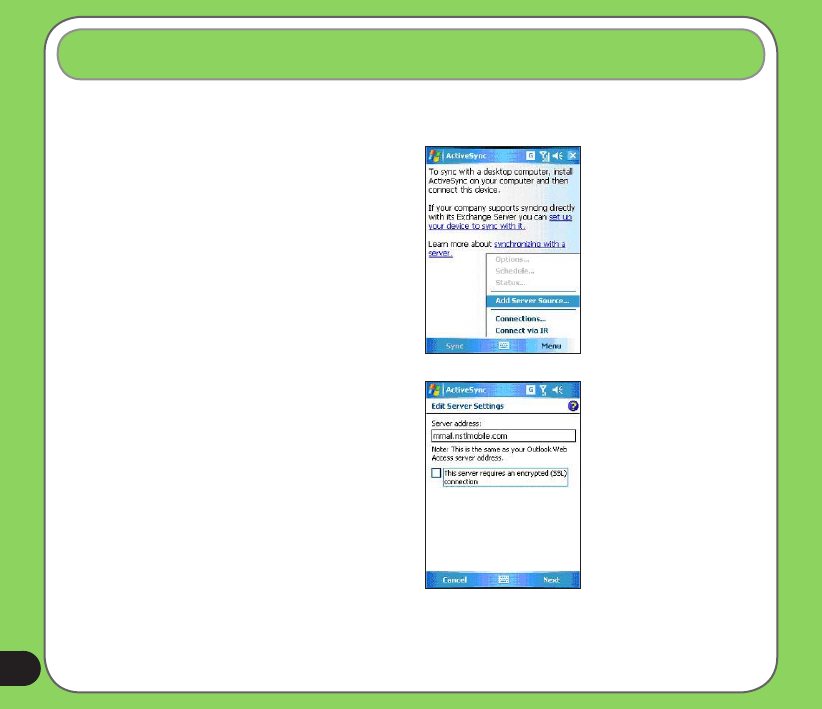
40
To synchronize your device with Exchange Server:
Synchronizing with Exchange Server
1. From the ActiveSync menu,
tap Menu > Add Server Source.
2. In the Server Address eld, input the
name of the server running Exchange
Server then tap Next.
If necessary, tap the check box
This server requires an encrypted
(SSL) connection.
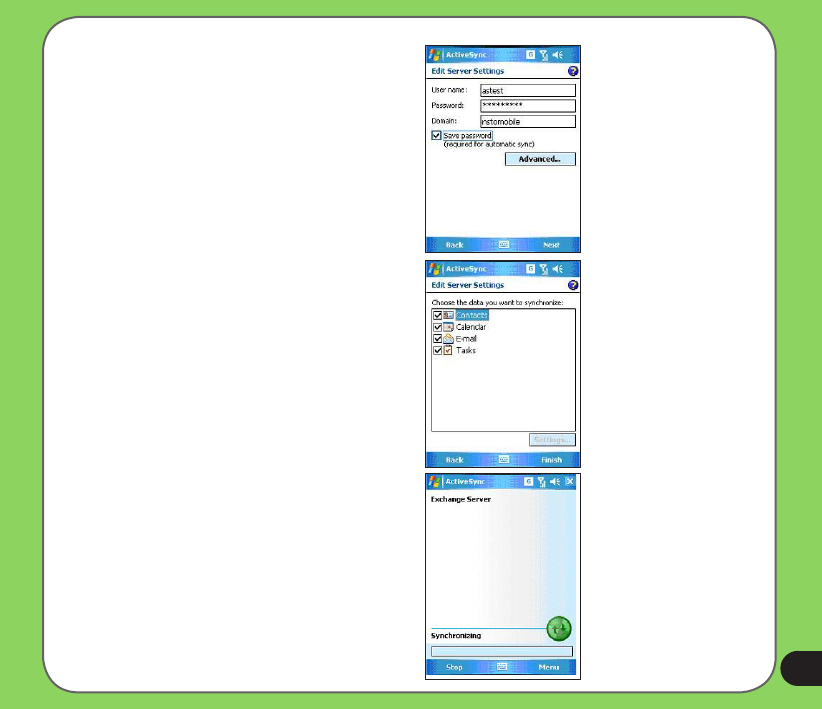
41
4. Tap the check boxes to select the data
items that you want to synchronize
with Exchange Server. To change the
available synchronization settings,
select a data item then tap Settings.
Tap Finish when done.
3. Input your name, password, and
domain then tap Next.
5. Start the sync process.
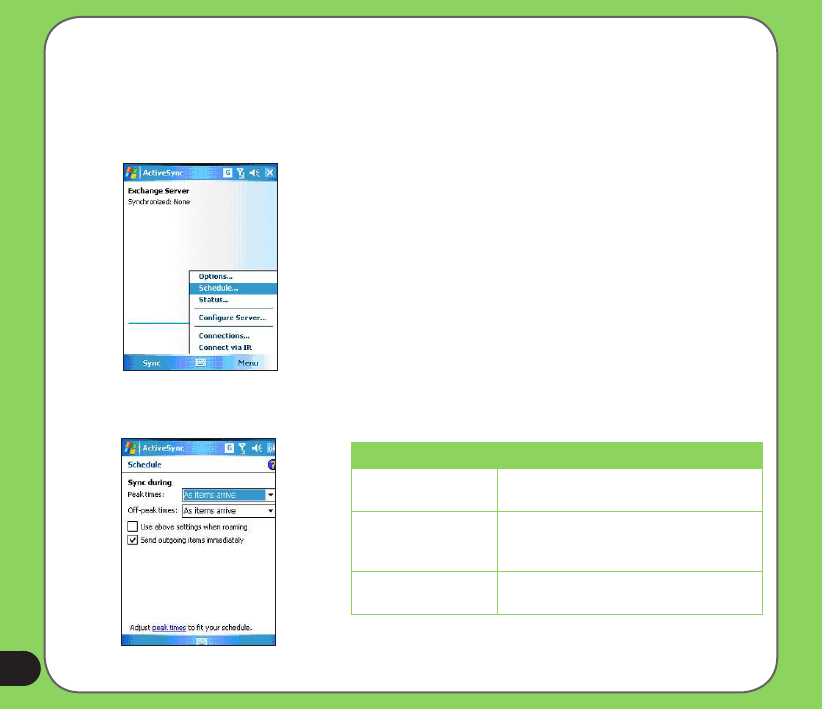
42
Setting the synchronization schedule
To set the synchronization with Exchange Server:
1. From the ActiveSync screen,
tap Menu > Schedule.
2. Refer to the table for input details.
Volume Recommended setup
High Select a shorter interval in the Peak
times list.
Low Select As items arrive option or
a longer interval in the Off-peak
times list.
While roaming Check Use above settings while
roaming.
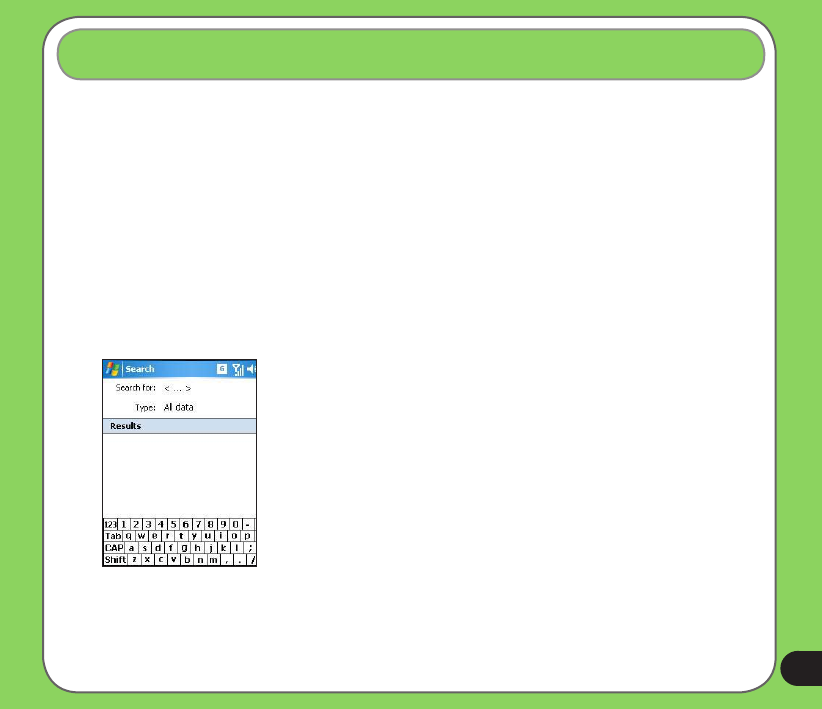
43
Searching information
Using the search tool, you can search for les and other items stored in your device or the
external MiniSD card. You can search by le name or by words located in various applications
including the Calendar, Contacts, Excel Mobile, Word Mobile, Outlook Mobile, Help, Messages,
Notes, and Tasks. You can also lter your search to les larger than 64 KB.
To search for a le or an item:
1. Tap Start > Programs > Search.
2. In Search for, input the le name, word, or other information you want to search.
3. In Type, select the data type to help you lter your search.
4. Tap Search. Found items are listed in Results.
5. In the Results list, tap the item for which your need information.
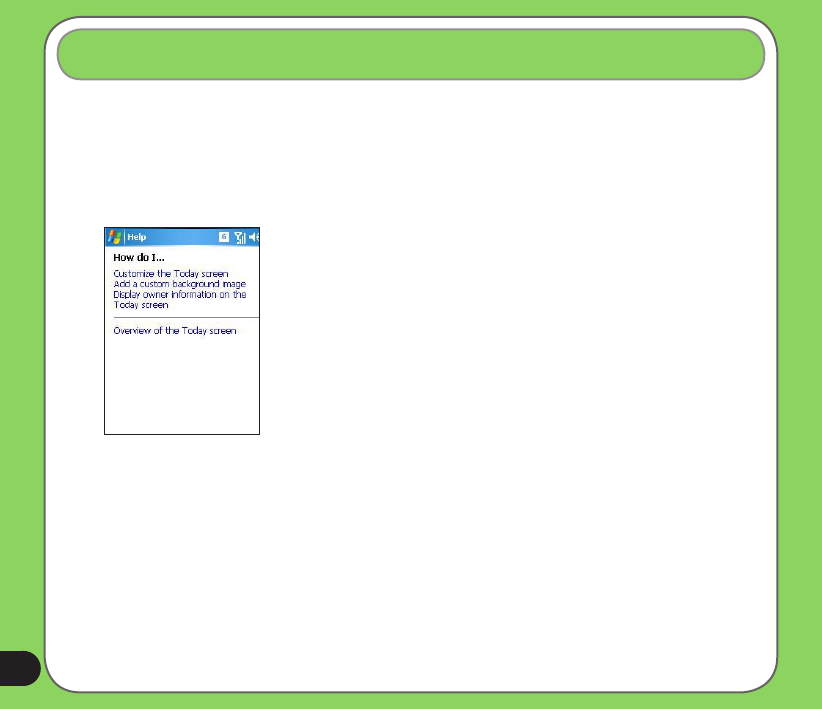
44
Getting Help
You can easily nd Help for using any program on the device.
To get help for a program:
• From the Today screen or program, tap Start > Help.
A page will open with links to topics that explain how to use the program.

45
Phone features
Chapter
• Using the phone
• Making a call
• Receiving a call
3
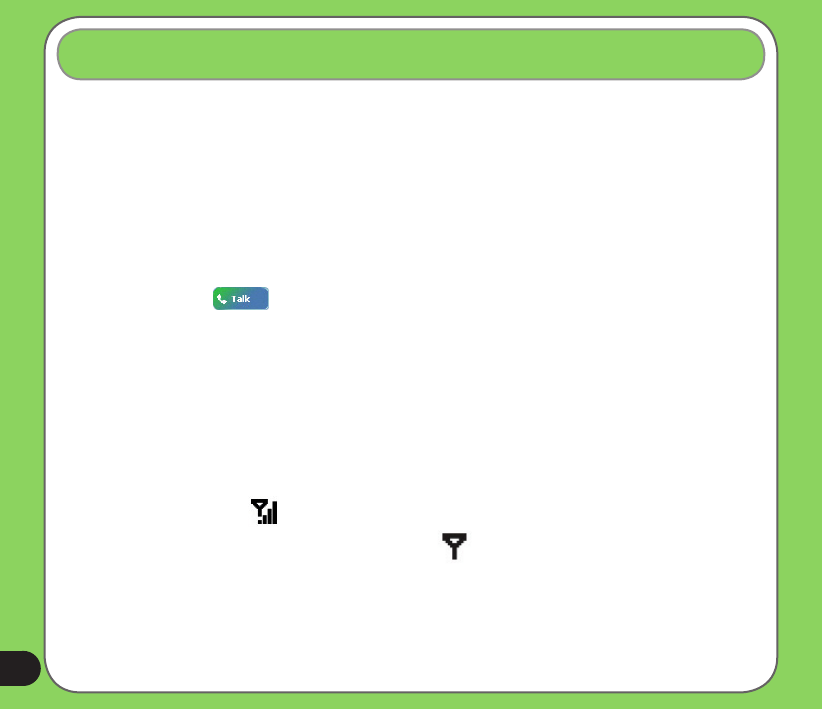
46
Using phone
Like a standard cellular phone, you can use your P525 to make and receive calls. You can also
keep a history of calls made and received, send SMS or MMS messages, take notes while
talking, call from Contacts, and copy SIM card contacts to your device.
Phone pad
The phone pad allows you to easily dial and access the Contacts, Call History, Speed Dial, and
Phone settings. To launch the Phone pad, do any of the following:
• Tap Start > Phone.
• Press the talk button.
• Directly dial the phone number you want to call using the numeric key pad.
• From the Today screen, press the left soft key.
Using ight mode
Generally, you are required to turn off your cellular phone onboard an aircraft during take-
off and landing. Flight mode enables you to turn off the phone function but keep your device
turned on to use other functions.
To use ight mode:
• Tap the signal icon then tap Turn on ight mode.
• To resume phone function, tap the signal icon then tap Turn off ight mode.
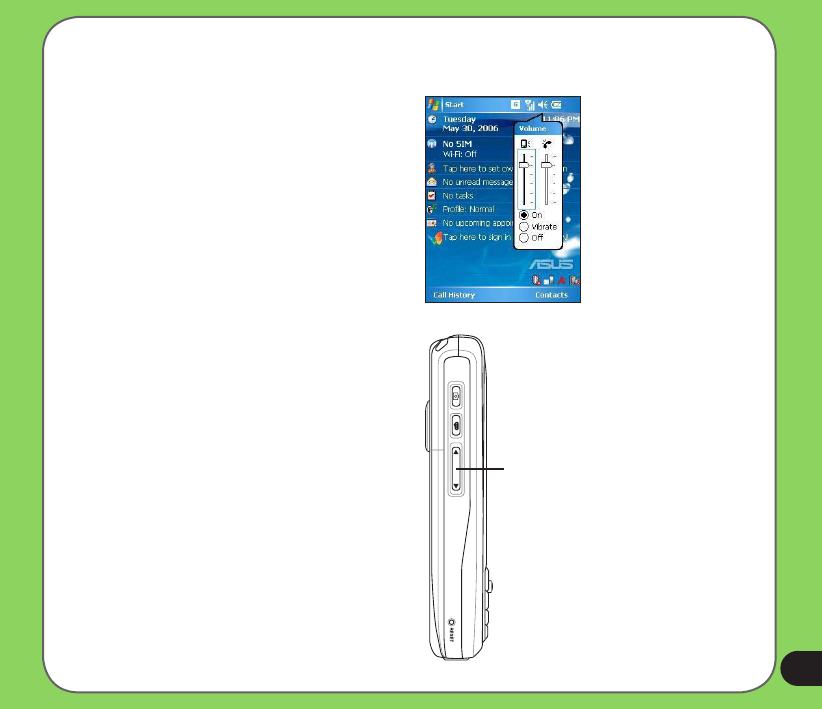
47
Adjusting the device volume
To adjust the device volume:
1. Tap the speaker icon.
2. From the volume menu, you can:
• Adjust the phone volume or device
volume by moving the slider to the
desired volume level.
• Tap On, Vibrate, or Off to change the
system and ringer volume settings.
You can also adjust the device volume by
pressing the volume controller keys at the left
side of the device.
Volume controller
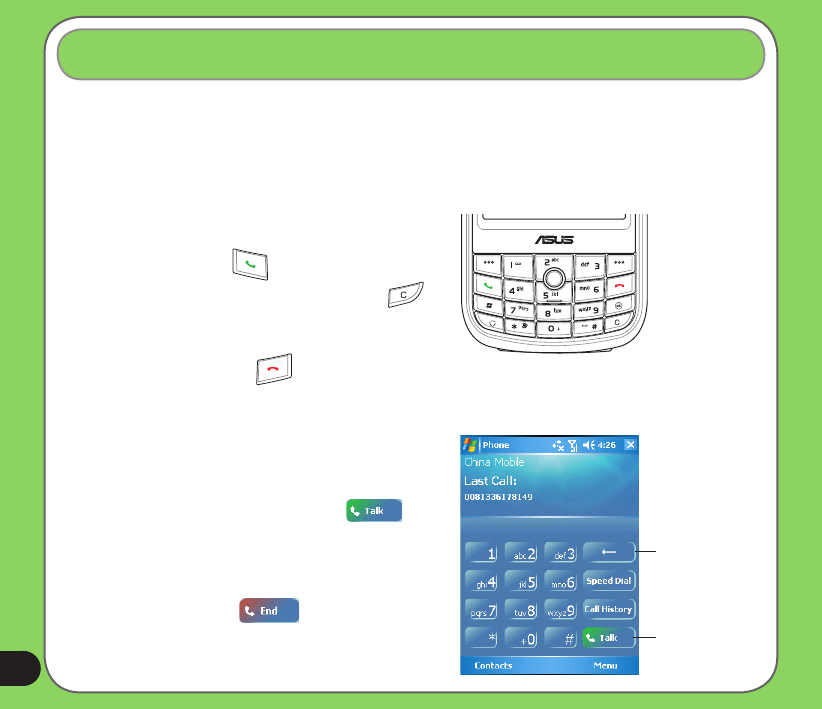
48
You can make a phone call using either the key pad or phone pad. You can also make calls
directly from the Contacts, Call History, Speed Dial, or Voice Commander.
Using the keypad
To make a call using the keypad:
1. Enter the number of the party you wish
to call, then press .
If you pressed the wrong number, press
to erase number to the left.
2. Talk to the called party when connected.
3. When nished, press to end the call.
Using the phone pad
To make a call using the phone pad:
1. Tap Start > Phone.
2. From the phone screen, tap the number of
the party you want to call then tap .
If you tap the wrong number, tap the back arrow
to erase number to the left.
3. Talk to the called party when connected.
4. When nished, tap to end the call.
Making a call
Back arrow
Talk button
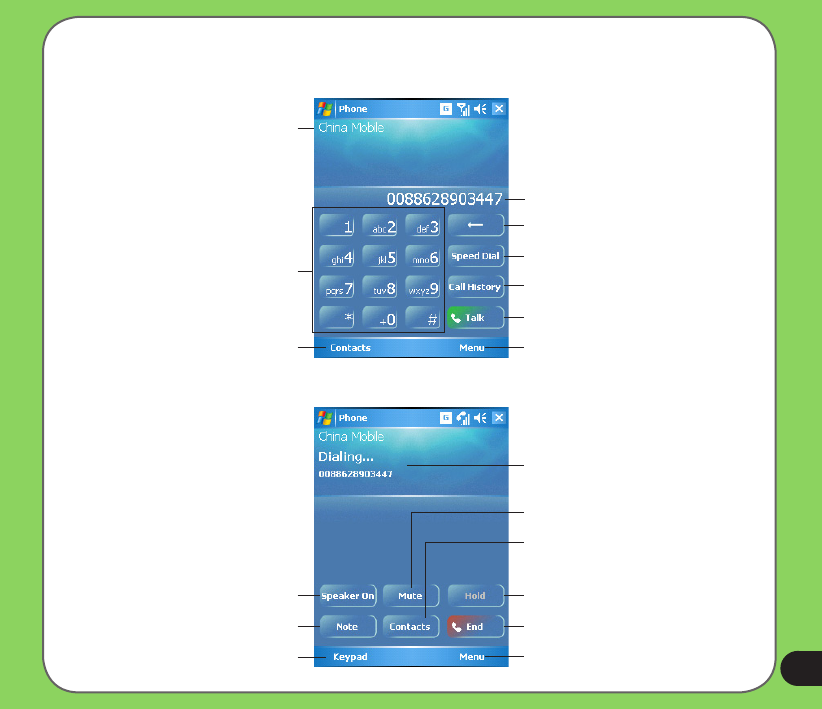
49
Dialled numbers appear here
Phone pad features
Press to delete number to the left
Press to set speed dial
Press to launch Call History
Press to make call
Press to launch menu
Press to launch Contacts list
Numeric keypad
Press to hold call
Press to end call
Press to launch menu
Displays the current call status
Press to mute
Press to launch Contacts list
Press to launch numeric keypad
Operator name
Press to turn speaker ON/OFF
Press to take notes
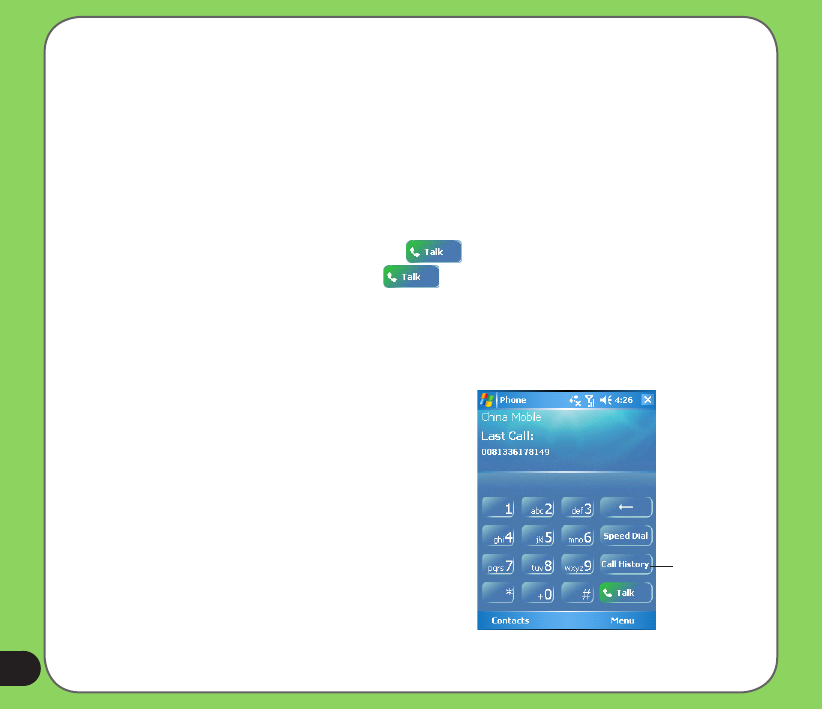
50
Making calls from Contacts
To make a call directly from Contacts:
1. Tap Start > Phone.
2. From the Phone pad, tap Contacts or press the Left soft key.
You can also launch Contacts from the Today screen by tapping Contacts on the menu
bar or pressing the Right soft key.
3. You can do any of the following to make a call:
• Tap to select a contact, then from the Contacts list, tap Call.
• Tap to select a contact, then press talk button.
• Select a contact then press the talk button twice. Once to send the number to
the Phone pad, and once to dial the number.
• You can also tap and hold the contact, and on the shortcut menu tap Call.
Making calls from Call History
• To make a call from the call history:
1. Tap Start > Phone.
2. On the Phone pad, tap the Call History button.
3. Scroll to the desired contact or phone number,
and tap Call.
To look for more numbers in other categories,
tap Menu > Filter and tap a category.
• You can also launch Call History in the Today screen
by pressing the left soft key.
Call History
button

51
Using the Speed Dial
With Speed Dial you can call frequently dialled numbers in a single tap. For example, if you
assign a contact to the number 2 button in Speed Dial, you can simply tap and hold on
the Phone pad to dial the contact’s number.
To create a Speed Dial entry:
1. Make sure that entry you want to create is already in the Contacts.
2. Tap Start > Phone.
2. On the Phone pad, tap the Speed Dial button.
3. Tap Menu > New.
4. Tap a contact from the list then tap Select.
5. In the Location box, select an available location for the new speed dial then tap OK.
To create a Speed Dial entry from Contacts:
1. From the Contacts list, tap and hold a contact name.
2. On the shortcut menu, tap Add to Speed Dial.
3. Select an available location for the new Speed Dial.
To delete a Speed Dial entry:
• In the Speed Dial list, tap and hold the desired entry and tap Delete.
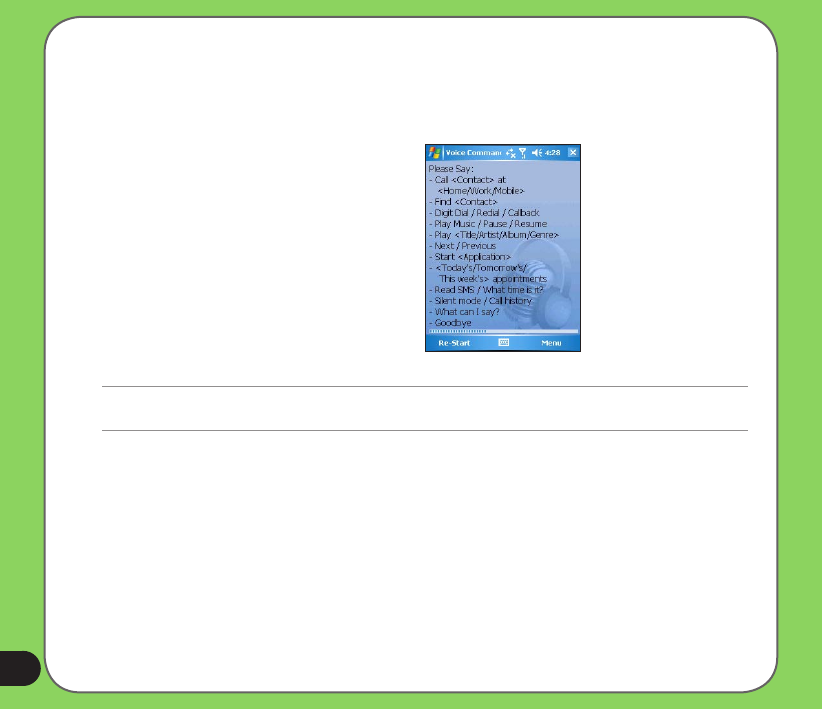
52
Using Voice Command
To make a phone call using voice command:
1. Press the voice command button on the left side of your device.
2. From the following screen, your device
asks you to “Say command.”
3. Audibly say “Call” then the name to call
from your Contact list.
4. Say “Yes” or “No” after the conrmation
question.
If you said “Yes”, the voice command
proceeds and dials the number;
otherwise, it returns to the voice
command menu.
5. Say “Goodbye” to exit voice command.
NOTES:
To use voice commander while using a headset, press the answer button on the headset then follow given instructions.
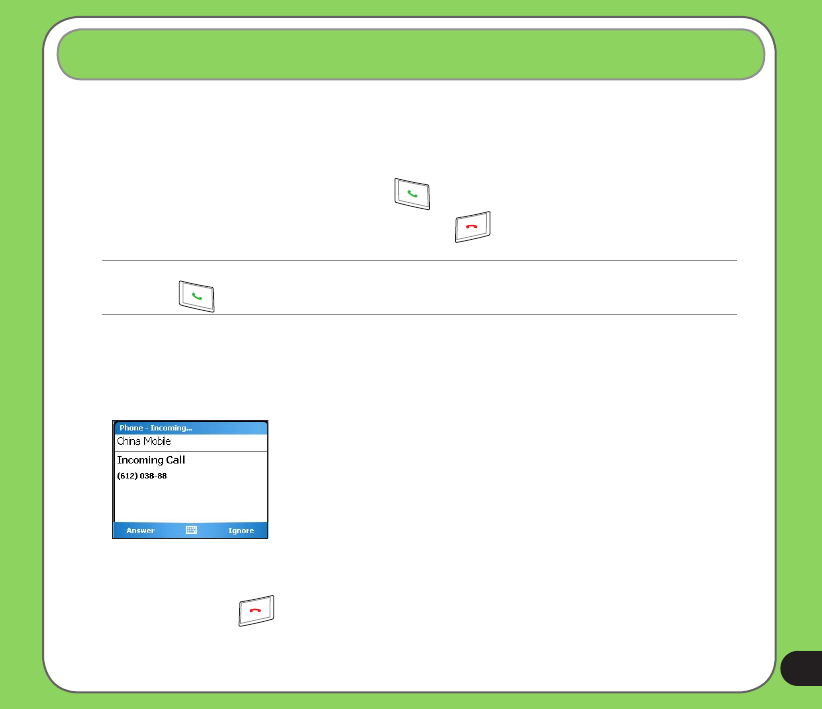
53
When you receive a call, a message will appear, giving you the option to answer or ignore the
incoming call.
To answer or reject an incoming call:
• To answer a call tap Answer, or press .
• To reject an incoming call, tap Ignore, or press .
TIP:
Long press to switch receiver to speakerphone mode.
Receiving a call
To terminate a call:
• Tap End or press on the device to terminate an incoming or outgoing call in progress.
The following pop-up screen appears during an incoming call:
• Tap Answer to receive call or
• Tap Ignore to dismiss call.

54

55
Wireless features
Chapter
• Using Bluetooth®
• Using WLAN (IEEE 802.11b)
• Using Infrared (IR)
• Setting a GPRS connection
4
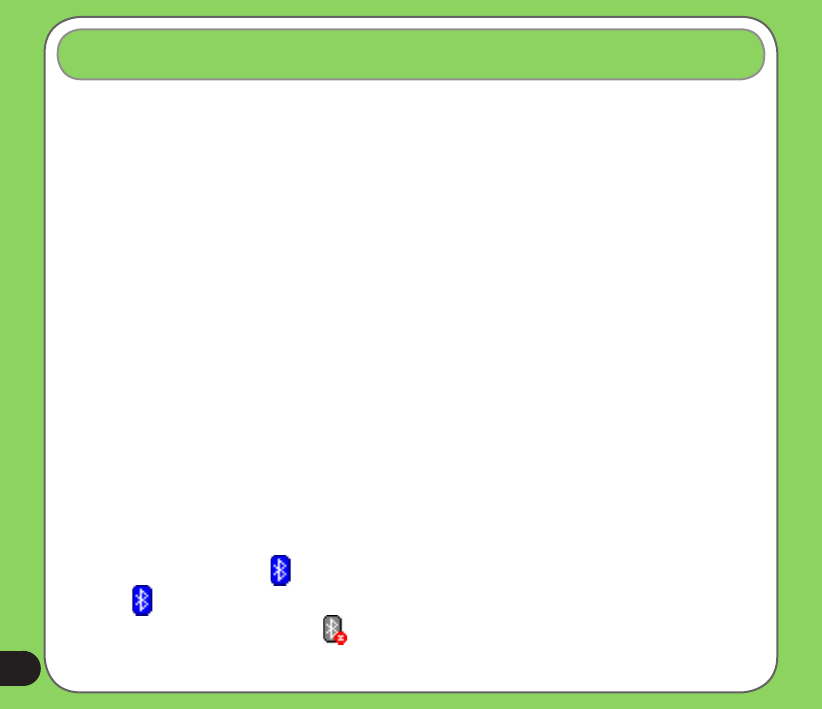
56
Overview
Bluetooth® is a short-range wireless communications technology that allows devices with
Bluetooth capabilities to exchange data within a radius of about 10 meters (30 feet) without
requring a physical connection.
With Bluetooth enabled in your device, you can:
• Connect and communicate (i.e. beam les, tasks, contacts) with other devices with
Bluetooth features.
• Use Bluetooth service. After you connect to another device or computer using
Bluetooth, you can use the services available on that device.
Activating Bluetooth in your device
To activate (turn ON) Bluetooth in your device:
1. Tap Start > Settings > Connections tab then tap the Bluetooth icon.
2. From the Bluetooth screen, tap General tab.
3. Tap Turn on button. The Bluetooth status is displayed above the Turn on/Turn off
buttons.
You can also turn Bluetooth On or Off from the Today screen.
To do this:
1. Find the Bluetooth icon at the botton right corner of the Today screen.
2. Tap to display shortcut menu then tap Turn Bluetooth ON.
The Bluetooth icon changes to if Bluetooth is turned Off.
Using Bluetooth®
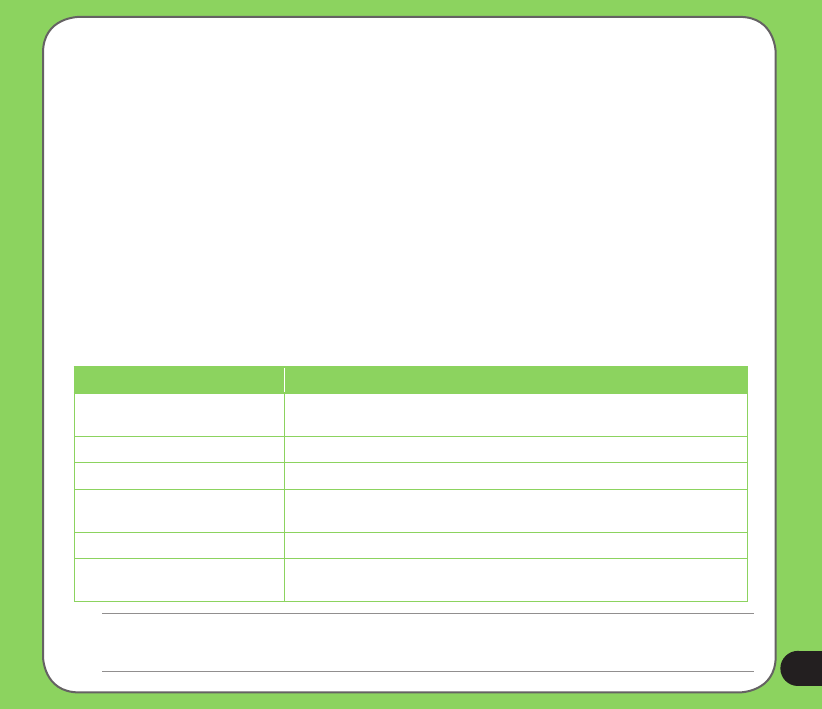
57
Conguring Bluetooth
To congure Bluetooth in your device:
1. Start > Settings > Connections tab then tap the Bluetooth icon.
2. From the Bluetooth screen, you can access the following tabs:
• General - allows you to set the user prole, turn Bluetooth on or off, displays the
Bluetooth status, and provides a link to the Bluetooth Manager.
• Accessibility - allows you to set the device name, see the Bluetooth Device Address,
select remote device you want to connect, and set whether to allow remote devices to
detect your device.
• Services - enable or disable available Bluetooth services, require authorization, set
authentication passkey, and set to require encryption. You can also access advanced
settings from this tab.
The available service settings are enabled when you select a Bluetooth service. Select a
service from the list to establish its settings.
Bluetooth Service Description
File Transfer Set the highest level directory on your device that remote devices can
access.
Information Exchange Sets the default business card.
Serial Port Displays the port addresses. This cannot be changed.
Personal Network Server Allows you to customise the service settings for your personal network
server.
Hands Free Enable telephone and/or audio prole.
Dial-up Networking Server Allows you to enable or authenticate, or both, the connections to the
dial-up network server.
NOTES:
The Bluetooth device setup instructions provided in this section may differ with other Bluetooth devices. If the
instructions in this guide differs from the documentation that came with your Bluetooth-enabled device, follow the latter.
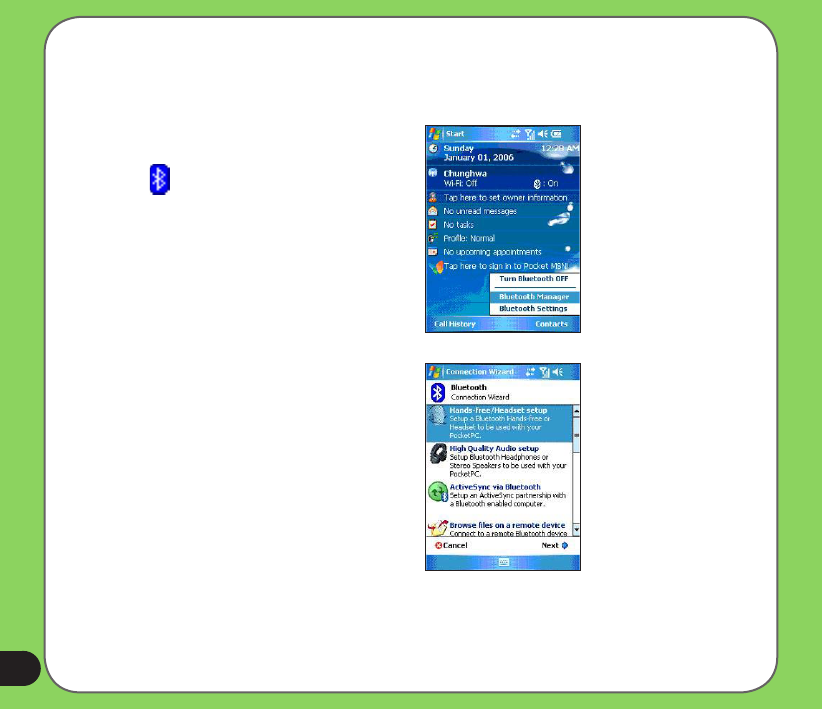
58
Using a Bluetooth-enabled headset
Mono headset setup
1. Make sure that Bluetooth is enabled
on your device.
2. Tap on the Today screen then on
the shortcut menu tap Bluetooth
Manager.
3. From the Bluetooth Manager, tap New.
4. From the Bluetooth Connection Wizard,
tap Hands-free/Headset setup then tap
Next.
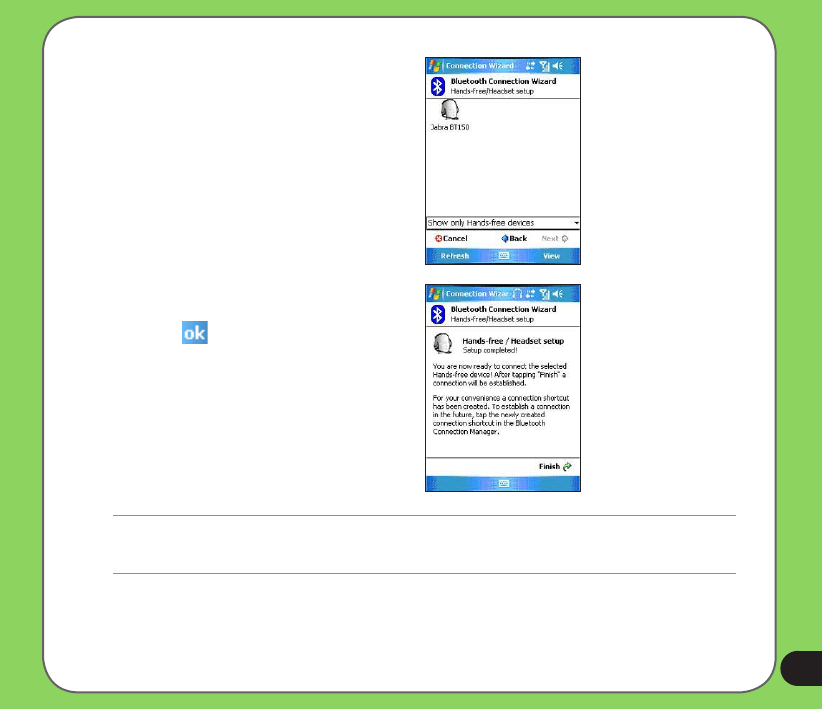
59
NOTES:
If the connection between the device and a Bluetooth headset fails, press the device icon then choose
“Re-connection”, you do not have to pair the devices again
7. In Passkey, input the alphanumeric
passkey of your headset device
then tap . You can nd this in the
documentation that came with your
headset device.
8. Tap Finish. You are now ready to use
your headset device.
5. Make sure that your headset device is
in pairing mode and ready to receive
incoming connection requests then tap
Next.
6. Tap the name of your Bluetooth-
enabled headset device then tap Next.
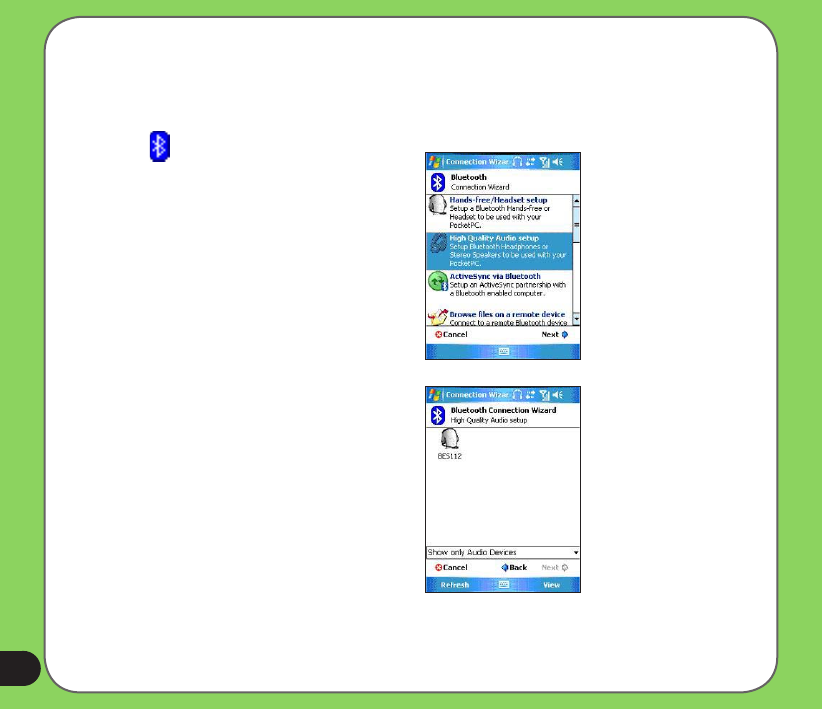
60
Stereo headset setup
P525 supports A2DP (Advanced Audio Distribution Prole), which is used by Bluetooth-enabled
stereo headsets. Make sure that your stereo headset also supports A2DP.
1. Tap on the Today screen then
on the shortcut menu tap Bluetooth
Manager.
2. From the Bluetooth manager screen,
tap New then select High Quality
Audio Setup.
3. Make sure that your stereo headset
device is in pairing mode and ready to
receive incoming connection requests
then tap Next.
4. Tap the name of your stereo headset
device then tap Next.
• If you want to create a shortcut, tap
the check box Create a shortcut
for this connection then input a
connection name.
• If you want to use a secure
connections, tap the check box
to Use a secure, encrypted
connection.
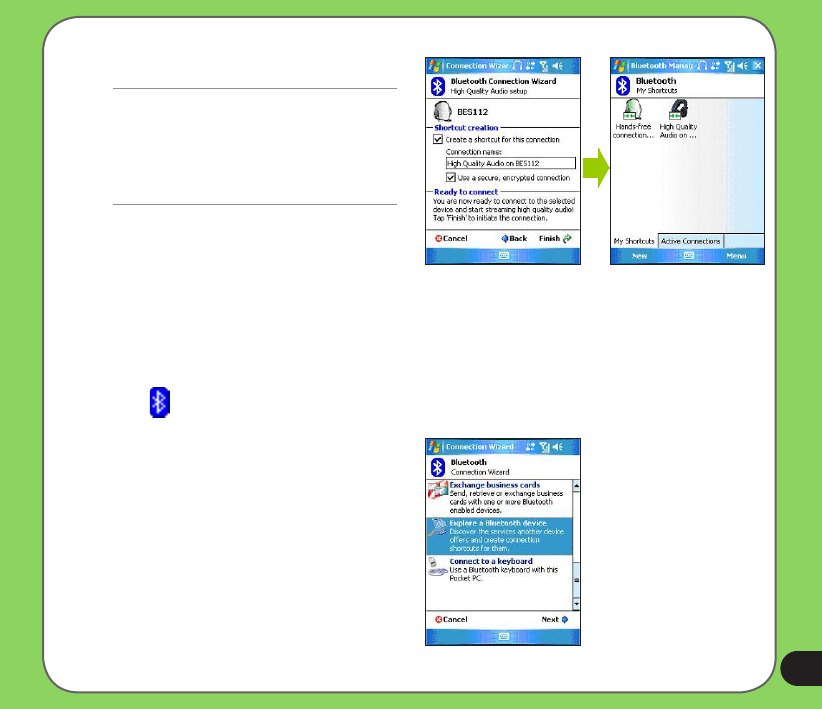
61
NOTES:
• To answer a phone call using your stereo
headset, make sure that you have mono and
stereo connection at the same time.
• To use voice commander while using a headset,
press the answer button on the headset then
follow given instructions.
5. Tap Finish to initiate connection.
Using a Bluetooth-enabled GPS
To congure a Bluetooth-enabled GPS device:
3. From the Bluetooth Manager, tap New.
4. Make sure that your GPS device is
in pairing mode and ready to receive
incoming connection requests.
5. From the Connection Wizard, tap
Explore a Bluetooth device then tap
Next.
1. Make sure that Bluetooth is enable on your device.
2. Tap on the Today screen then on the shortcut menu tap Bluetooth Manager.
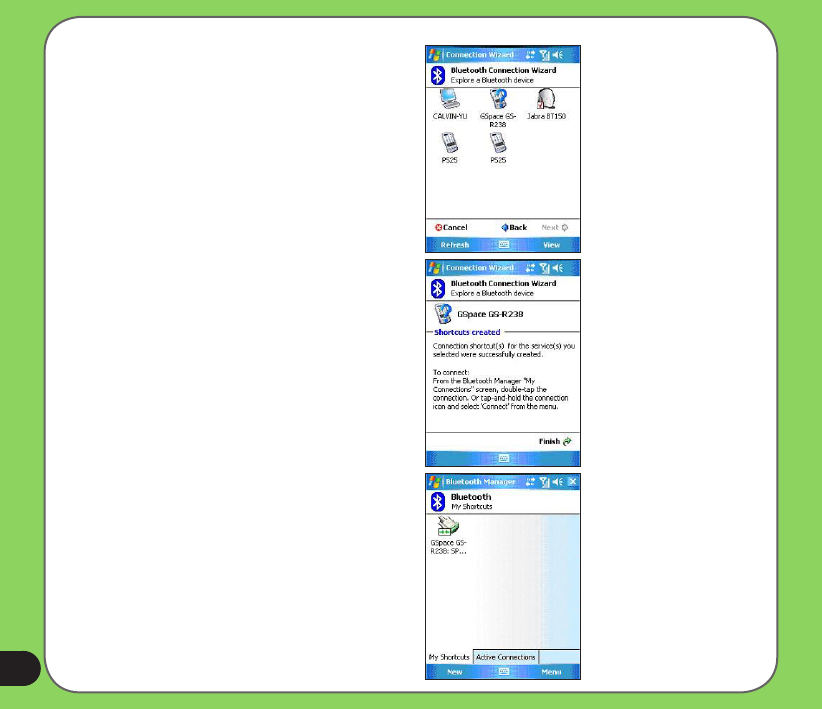
62
6. Tap the name of your Bluetooth-
enabled GPS device then tap Next.
7. Select SPP Slave in the Service
Selection list then tap Next.
8. Tap Finish.
9. Tap and hold the shortcut icon to
display shortcut menu then tap
Connect.
10.In Passkey, input the alphanumeric
passkey of your headset device
then tap OK. You can nd this in the
documentation that came with your
headset device.
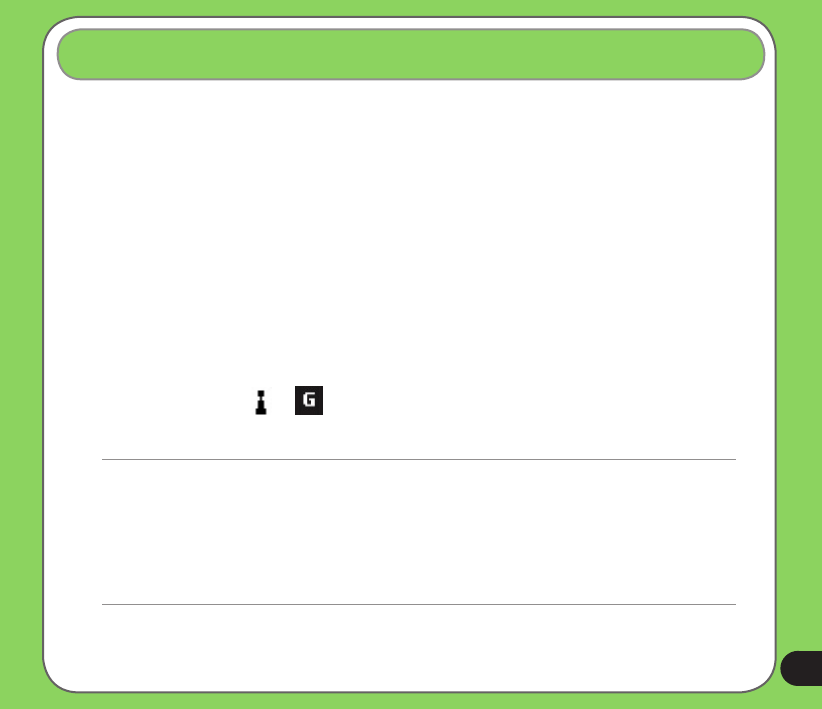
63
Introduction
WLAN (IEEE 802.11b), refers to certain types of wireless local area network (WLAN) that
use specications in the 802.11 family. Created by the Wi-Fi Alliance, a nonprot international
association to certify interoperability of wireless local area network products. Any device
tested and approved by the Wi-Fi Alliance are certied as interoperable with each other even
if they are from different manufacturers.
Activating WLAN in your device
To activate WLAN in your device:
1. Tap Start > Settings > Connections tab then tap the Wi-Fi Manager icon.
2. From the Wi-Fi Manager screen, tap Menu then Turn Wi-Fi On.
You can also turn Wi-Fi ON or OFF from the Today screen:
1. Tap the Wi-Fi icon or on the status bar.
2. From the pop-up callout, tap Turn on Wi-Fi.
Using WLAN (IEEE 802.11b)
NOTE:
• When WLAN is used simultaneously with the GPRS, the latter will get signal priority. We recommend not to use
WLAN and GPRS at the same time.
• We recommend not to use WLAN and the Bluetooth function at the same time. Disturbance in data transmission is
possible since both use the same wireless channel.
• The WLAN and USB connections can not be used at the same time.
• When the battery power is less than 20% the device prompts a warning message whether to continue using WiFi or
not. Tap “Yes” to continue using or “No” to disconnect. In any case, we recommend that you plug the power adapter
immediately to avoid losing data.
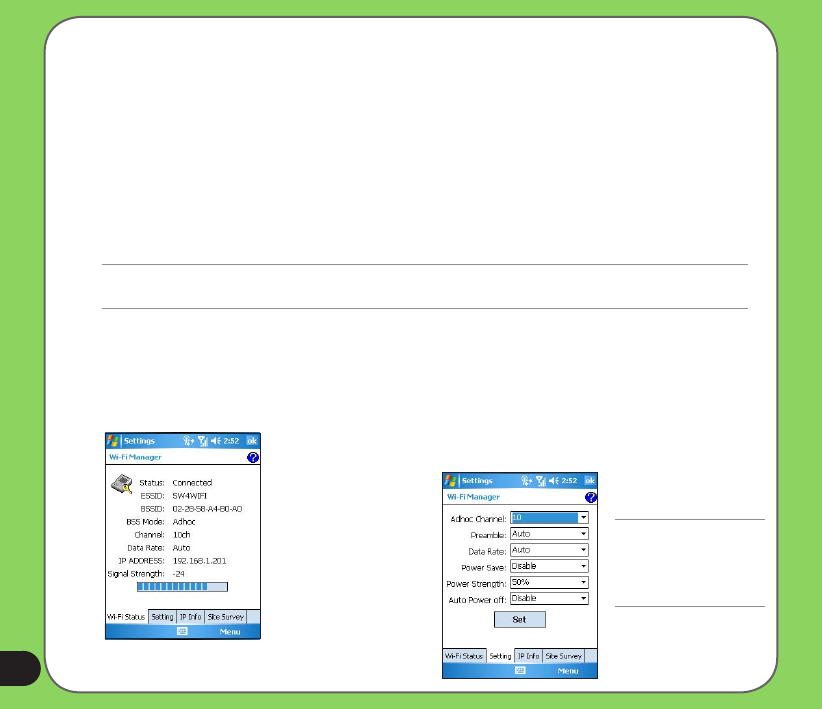
64
Conguring WLAN
To congure WLAN in your device:
1. Start > Settings > Connections tab then tap the Wi-Fi Manager icon.
2. From the Wi-Fi Manager screen, you can access the following tabs:
• Wi-Fi Status
• Setting
• IP Info
• Site Survey
NOTE:
Tap ? for Wi-Fi Help.
Wi-Fi Status
Displays the Wi-Fi status, ESSID, BSSID,
BSS mode, channel, data rate,
IP Address, and signal strength.
Setting
Allows you to set the Adhoc channel,
preamble, data rate, enable or
disable power save feature, set power
strength, and enable or disable auto
power off feature.
NOTE:
The Power Save
feature reduces data
transmission rate but
improves the battery life.
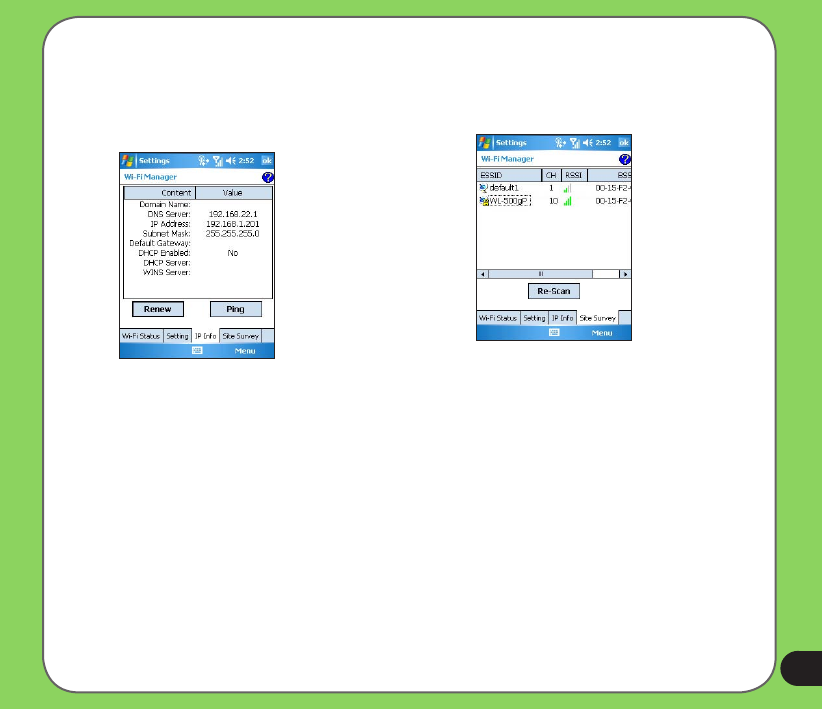
65
IP Info
Displays the network information and
allows you to renew or ping a network
connection.
Site Survey
Shows the available wireless networks
in the area.
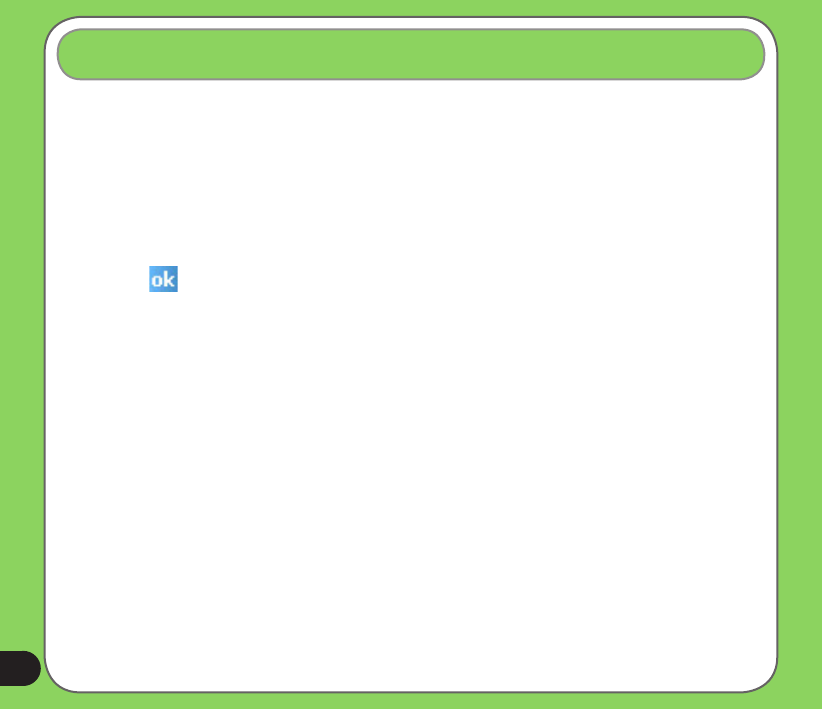
66
You can use your device to connect to another device with infrared capabilities.
To connect to another device via infrared:
1. Setup the device you want to connect to receive infrared beams. Refer to the technical
documentation that came with the device.
2. Congure your device to receive infrared beams. Tap Start > Settings > Connections
tab then tap Beam icon.
3. Tap to check Receive all incoming beams.
4. Tap .
5. Line up the infrared ports of both devices. Make sure that they are unobstructed and
within range.
6. Send data from the source device. Upon connection, your device prompts that data is
being received. Tap Cancel if you want to stop transfer.
7. When nished, tap Yes to accept and save data or tap No to discard data.
Using Infrared (IR)
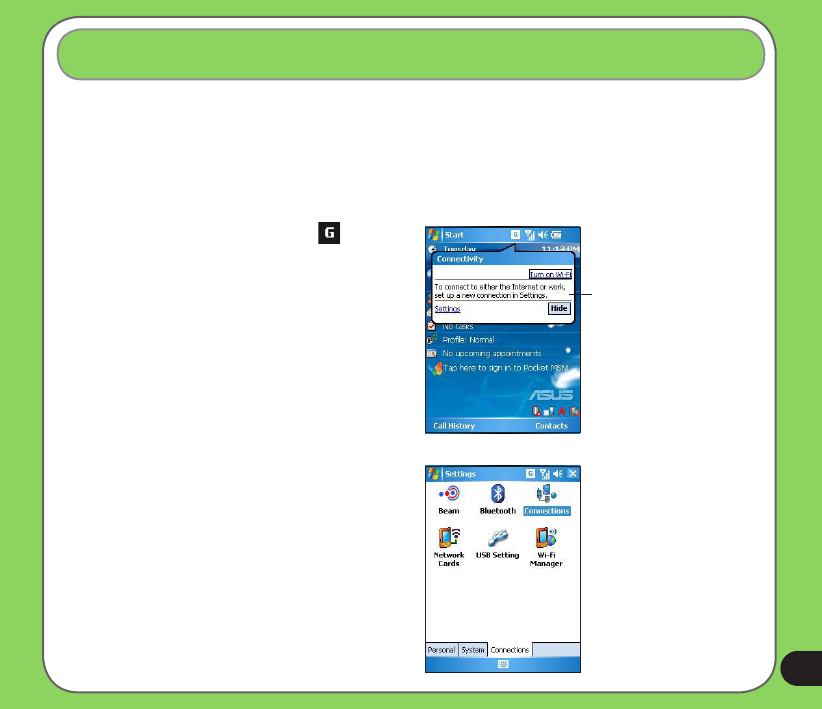
67
Your P525 allows you to connect via General Packet Radio Service (GPRS). GPRS is a
wireless communication standard that runs at speeds of up to 115 kbps, compared to 9.6
kbps of the current Global System for Mobile Communications (GSM). It supports a wide
range of bandwidths that allows sending and receiving small bursts of data, such as email
and web browsing. To set a GPRS connection in your device:
Setting a GPRS connection
1. From the Today screen, tap on the
status bar.
2. From the pop-up callout, tap Settings.
3. From the Settings screen, select
the Connections tab then tap
Connections icon.
Pop-up callout
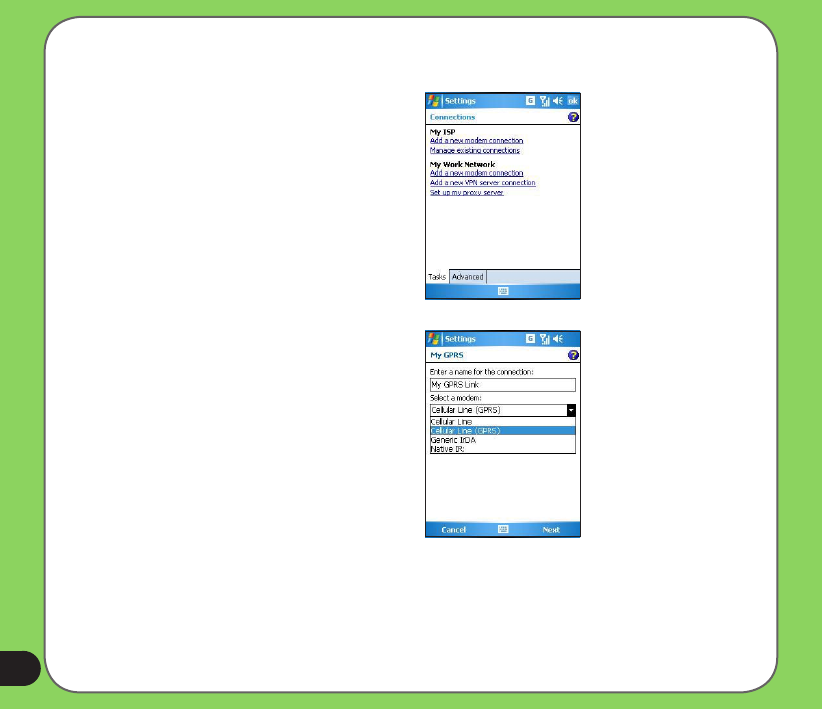
68
4. From the Connections screen, tap Add
a new model connection.
5. Input a unique name for the connection
then select Cellular Line (GPRS) from
the modem list.
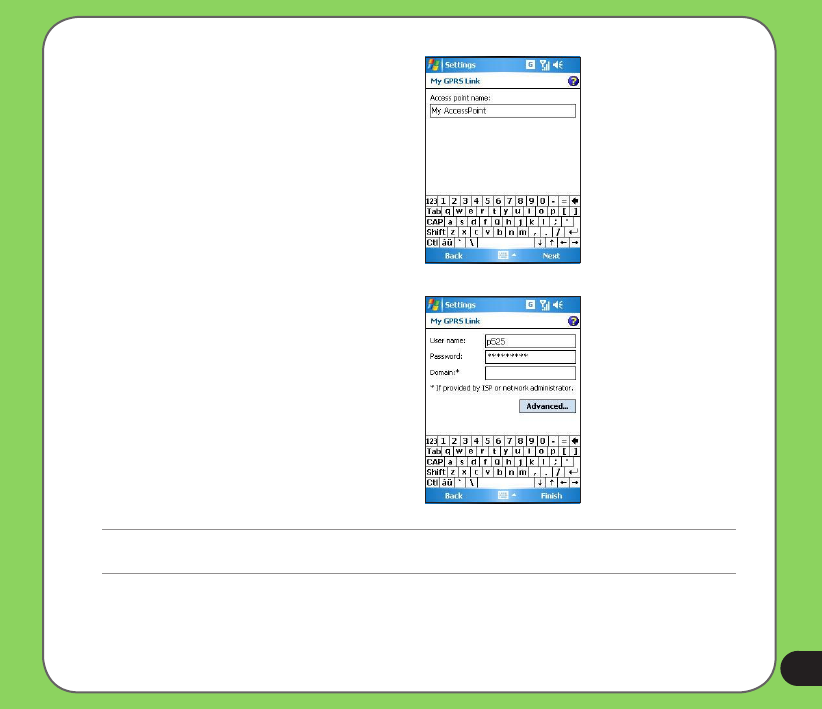
69
6. Input the Access point name.
7. Input your user name, password, and
domain then tap Finish. Contact your
network administrator for assistance.
NOTE:
The GPRS and USB connections can not be used at the same time.
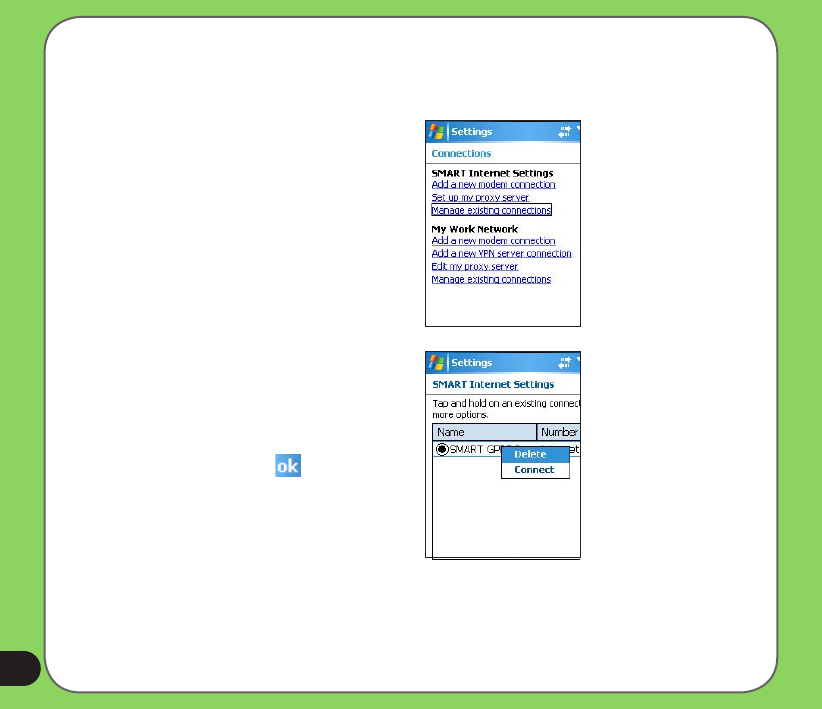
70
Connecting GPRS
To connect GPRS:
1. Tap Start > Settings > Connections
tab then tap Connections icon.
2. From the Connections screen, tap
Manage existing connections.
3. Tap and hold on an existing connection
then from the pop-up menu tap
Connect.
Tap Delete if you want to delete
selected connection setting.
4. When connected, tap to exit.
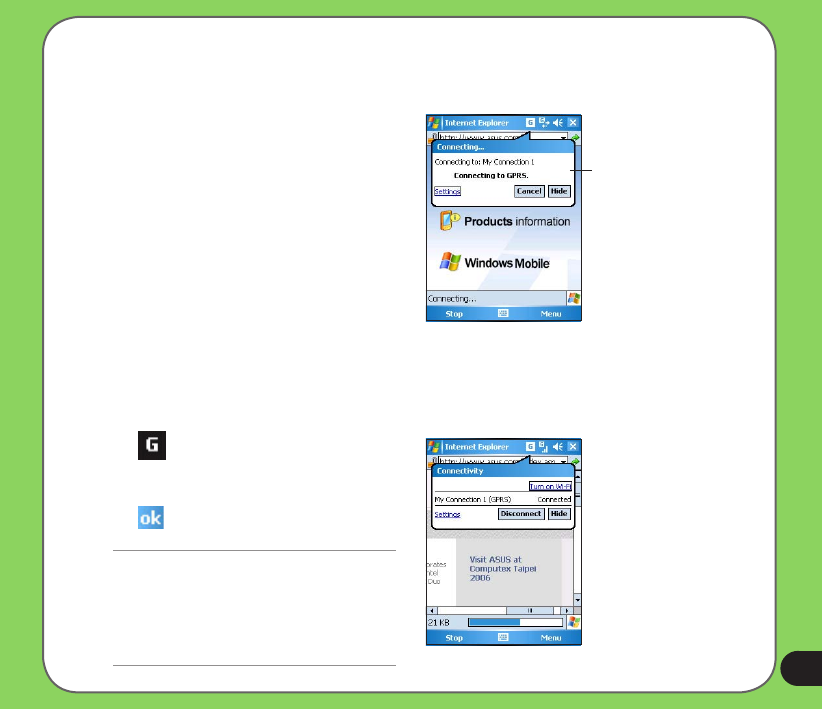
71
Disconnecting GPRS
To disconnect GPRS:
1. Tap from the status bar.
2. From the pop-up callout, tap
Disconnect.
3. Tap to exit.
If you have set a default GPRS connection, it automatically connects when you launch an
application that connects to the Internet.
1. Launch any application that connects
to the Internet (e.g. Internet Explorer).
The device will automatically connect
your default GPRS connection. A
pop-up callout appears to display the
connection status.
2. When connected, you can start
browsing the Internet. If you’re using
Internet Explorer, the default site will
be displayed.
Pop-up callout
NOTE:
• If your ActiveSync is set to sync with Exchange
Server automatically, synchronization will occur
after you connect again.
• GPRS will automatically reconnect everytime
you launch an application that requires GPRS
connection (e.g. Internet Explorer, Pocket MSN).
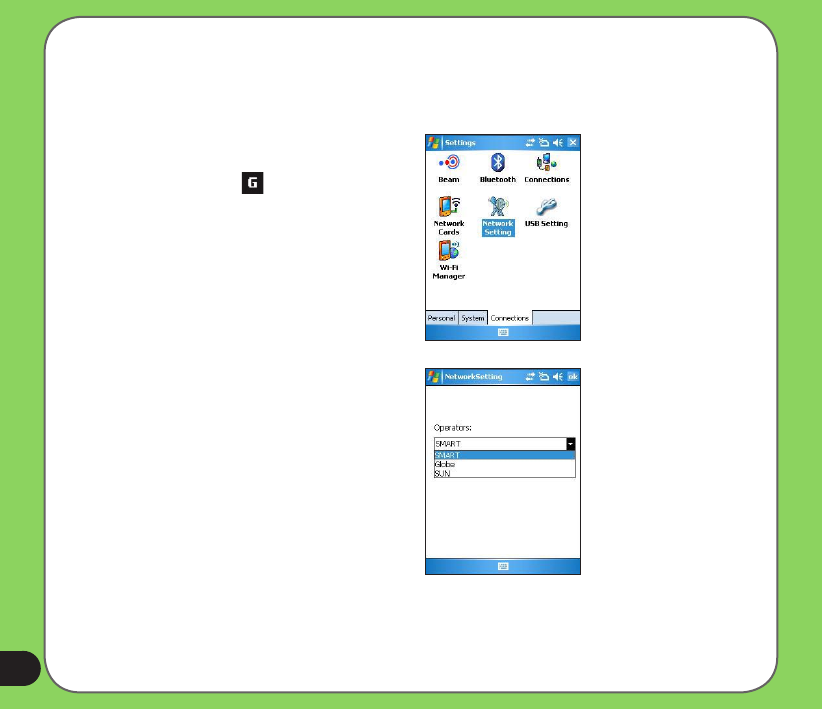
72
Using the GPRS Tool
The GPRS Tool allows you to conveniently select and connect to your GPRS service provider.
To connect via GPRS Tool:
1. Tap Start > Settings > Connections
tab then tap the Network Setting icon.
You can also tap on the status bar
then tap Settings from the pop-up
callout.
2. From the Network Setting screen,
select your GPRS provider from the
list.

73
My Secrets
Chapter
• Using My Secrets
5
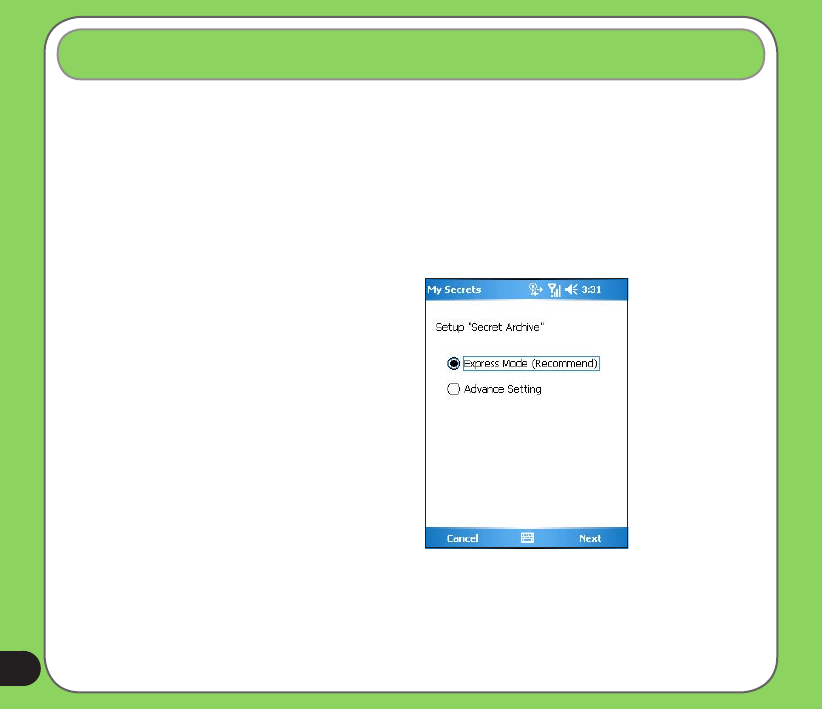
74
My Secrets is a secret archive to keep your classied documents, pictures and video. The
items placed in the My Secrets folder are encrypted for protection. A user-dened password is
required to unlock the folder or change the settings.
Enabling My Secrets
To enable My Secrets using Express Mode (recommended):
1. Tap Start > Programs then tap My Secrets icon.
Using My Secrets
2. Tap Express Mode (Recommended)
then tap Next.
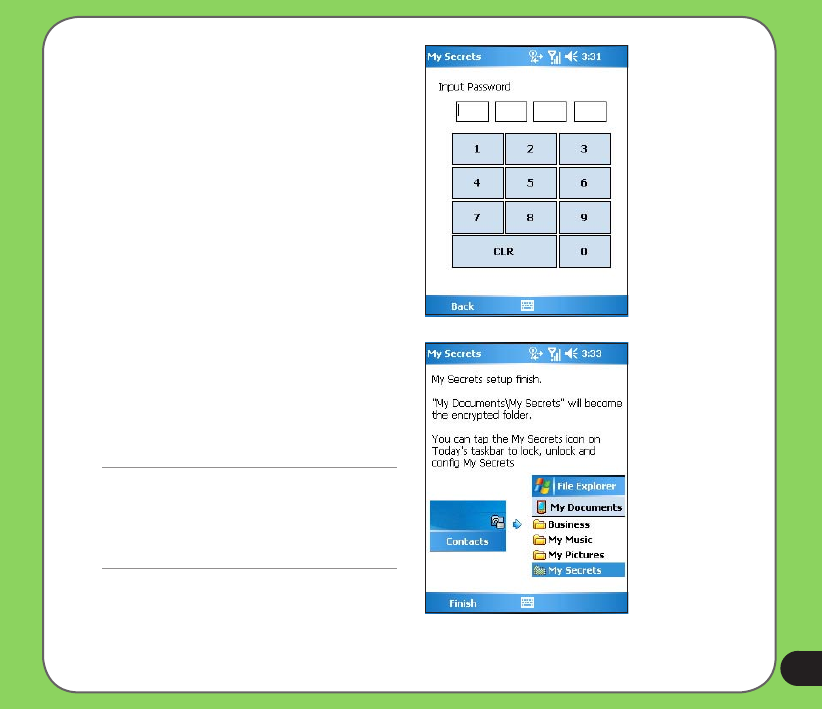
75
3. Key in a 4-digit password.
4. When prompted, key in the same
password again to conrm.
5. Tap Finish.
When nished, the
My Documents\My Secrets becomes
an encrypted folder. You can now start
using this folder.
IMPORTANT:
• When locked, the My Secrets folder is hidden. Use
password to unlock folder and access les.
• You can tap the My Secrets icon on the Today
screen to lock, unlock, and congure My Secrets.
See next page for details.
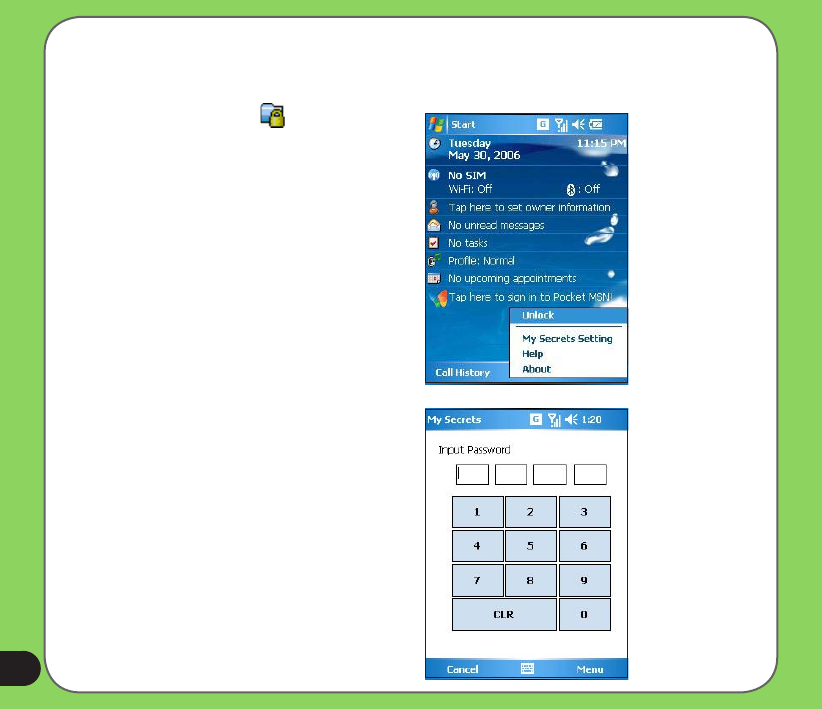
76
Unlocking My Secrets
To unlock My Secrets:
1. Tap the My Secrets icon on the
Today screen.
2. From the shortcut menu, tap Unlock.
3. Key in correct password.
You can now use My Secrets folder.
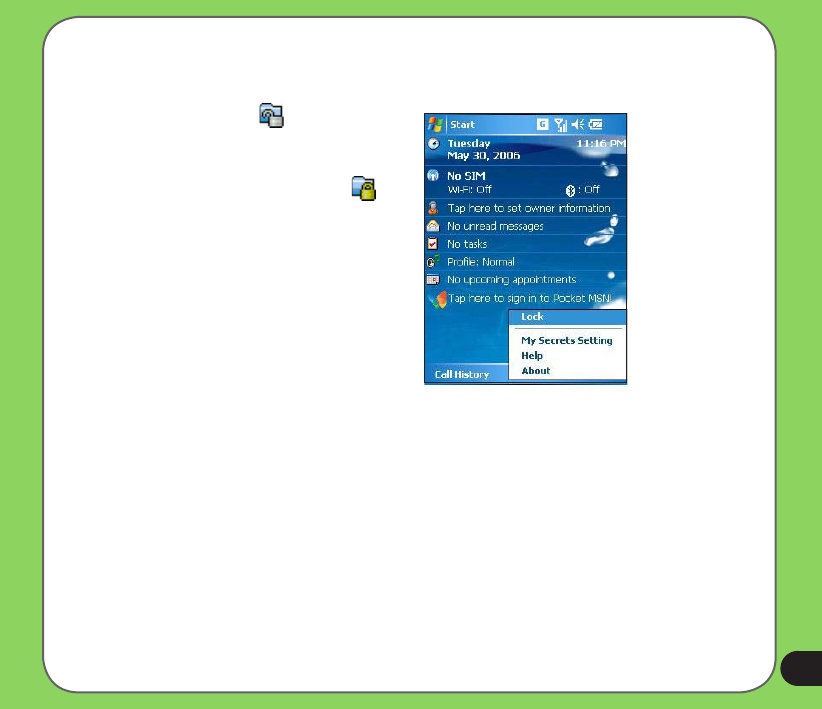
77
Locking My Secrets
To lock My Secrets:
1. Tap the My Secrets icon on the
Today screen.
2. From the shortcut menu, tap Lock.
The My Secrets icon changes to
indicating that the My Secrets folder is
locked.
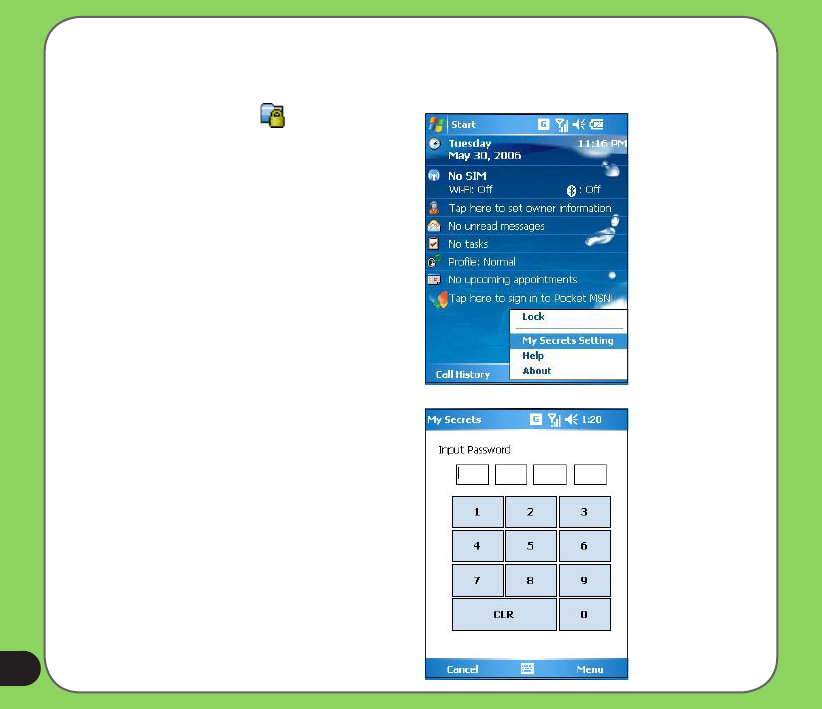
78
My Secrets setting
To modify the My Secrets settings:
1. Tap the My Secrets icon on the
Today screen.
2. From the shortcut menu, tap My
Secrets Setting.
3. Key in correct password.
My Secrets Setting allows you to
modify any of the following:
• Security setting
• Password
• Password Hint
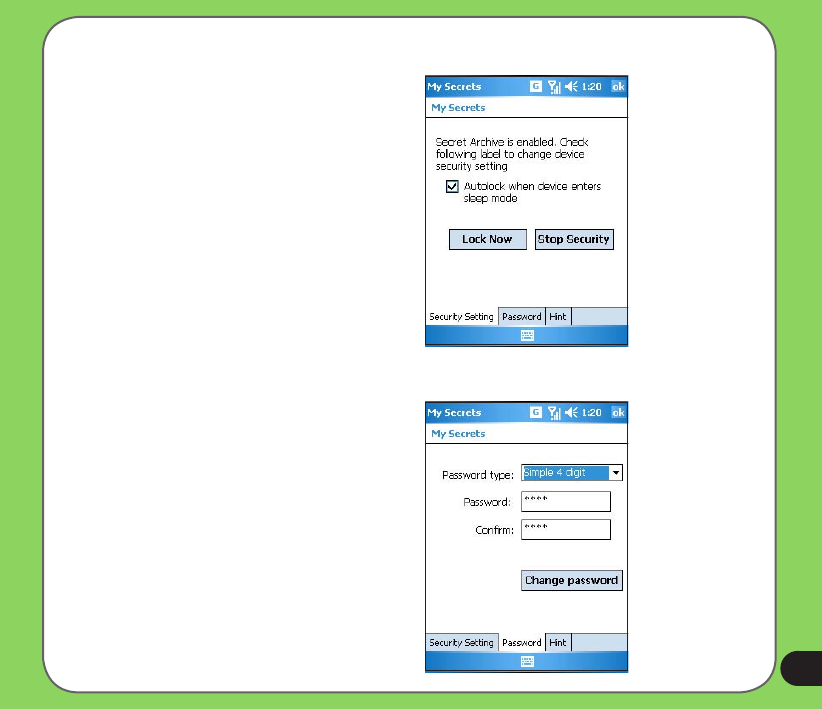
79
Security Setting
Security setting allows you to enable
or disable autolock when the device
enters sleep mode, lock the device
now, or stop security.
Password
The Password tab allows you to
change the password and password
type.
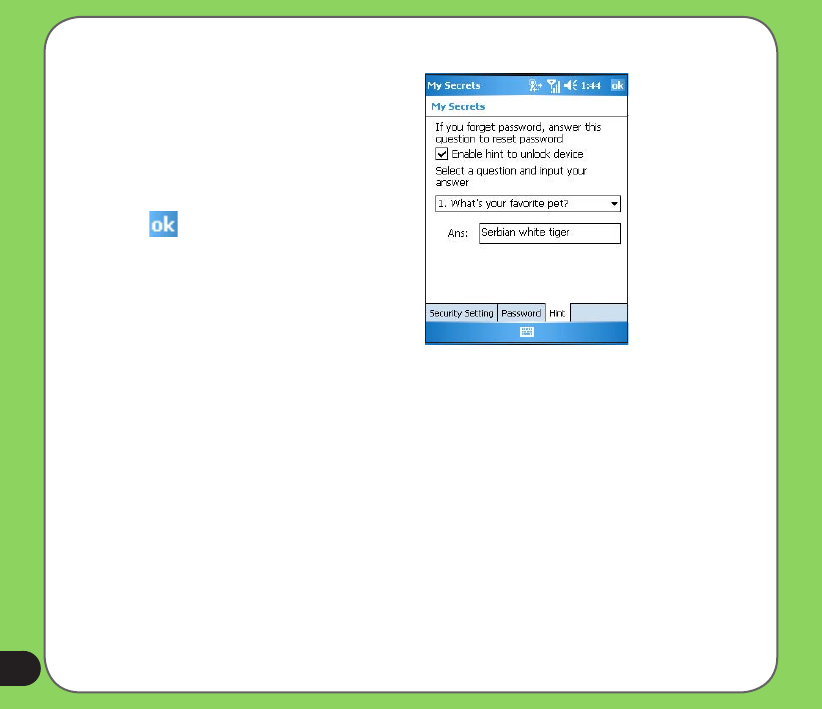
80
Hint
Set a hint in case you forget your
password.
• Tap check box to enable or disable
use of hint to unlock the device.
• Select one of the predened
questions then key in answer.
4. Tap when nished.